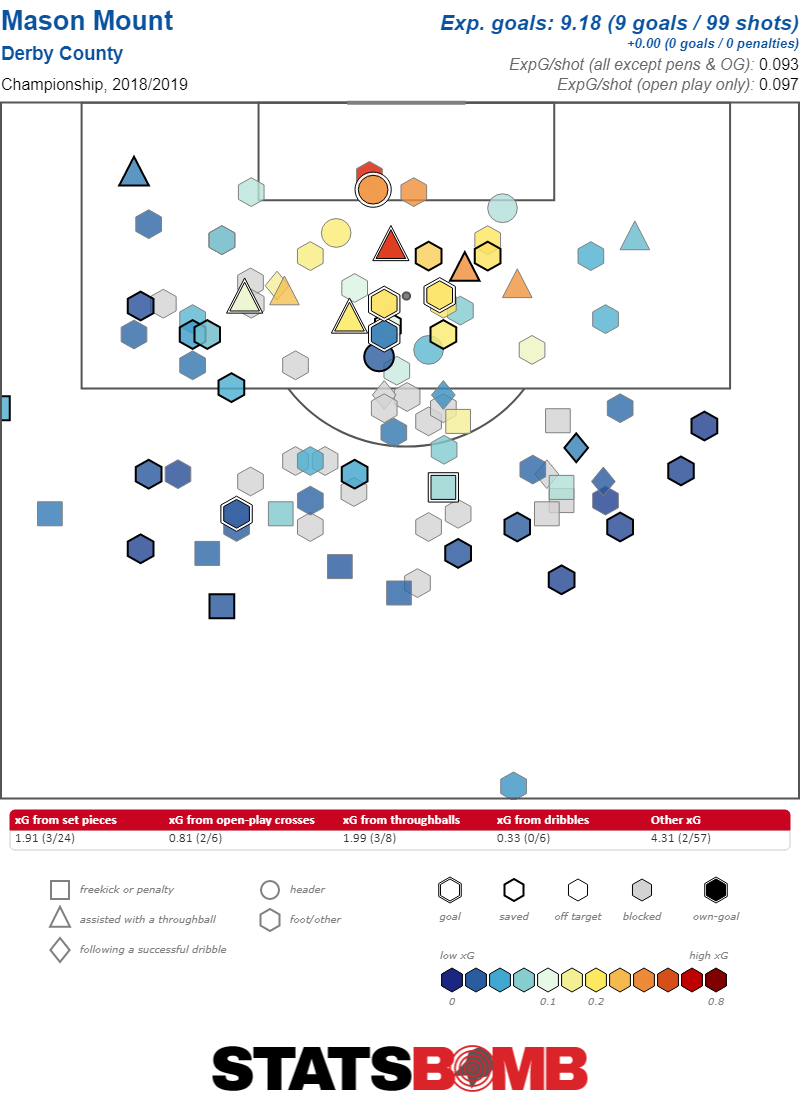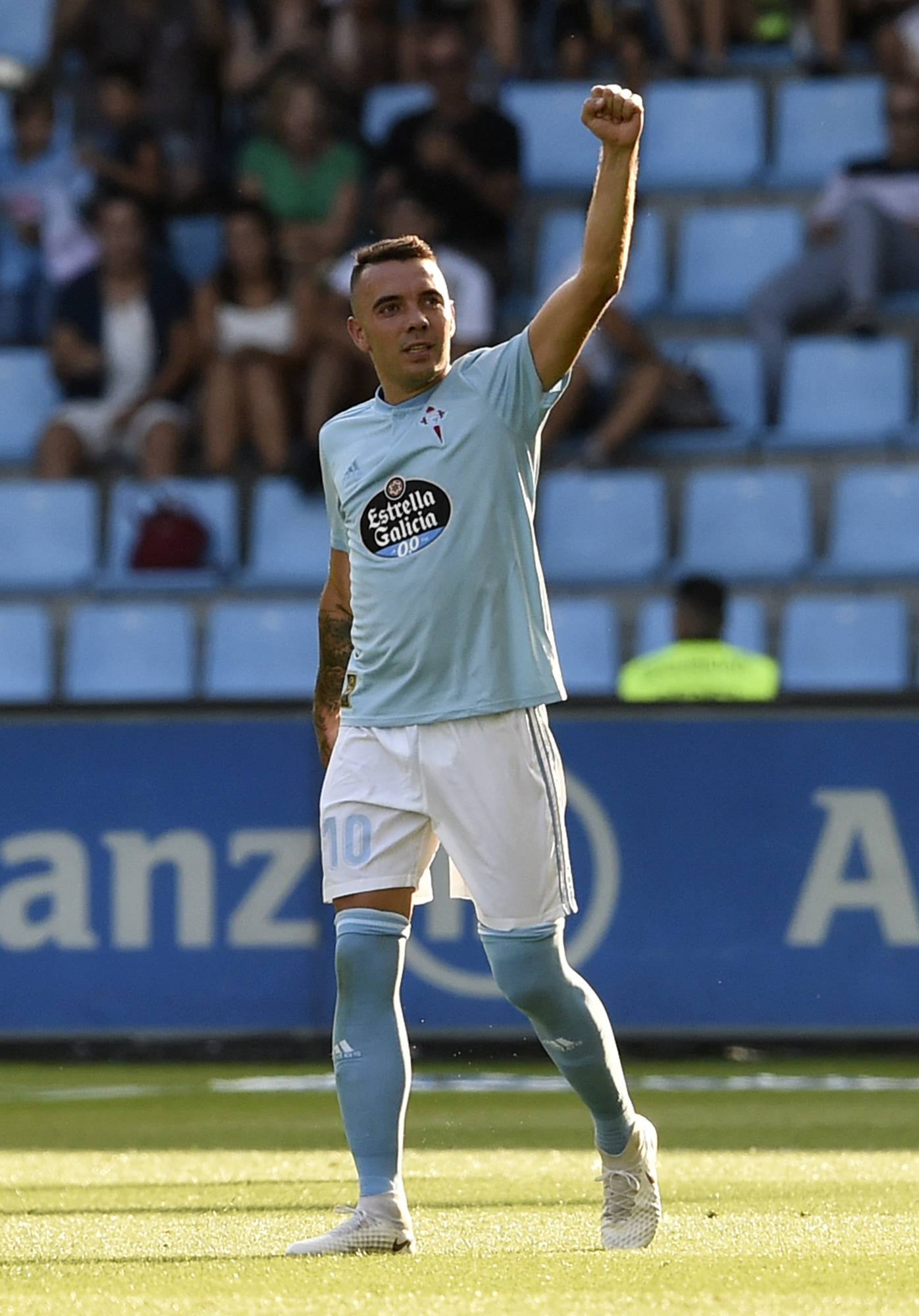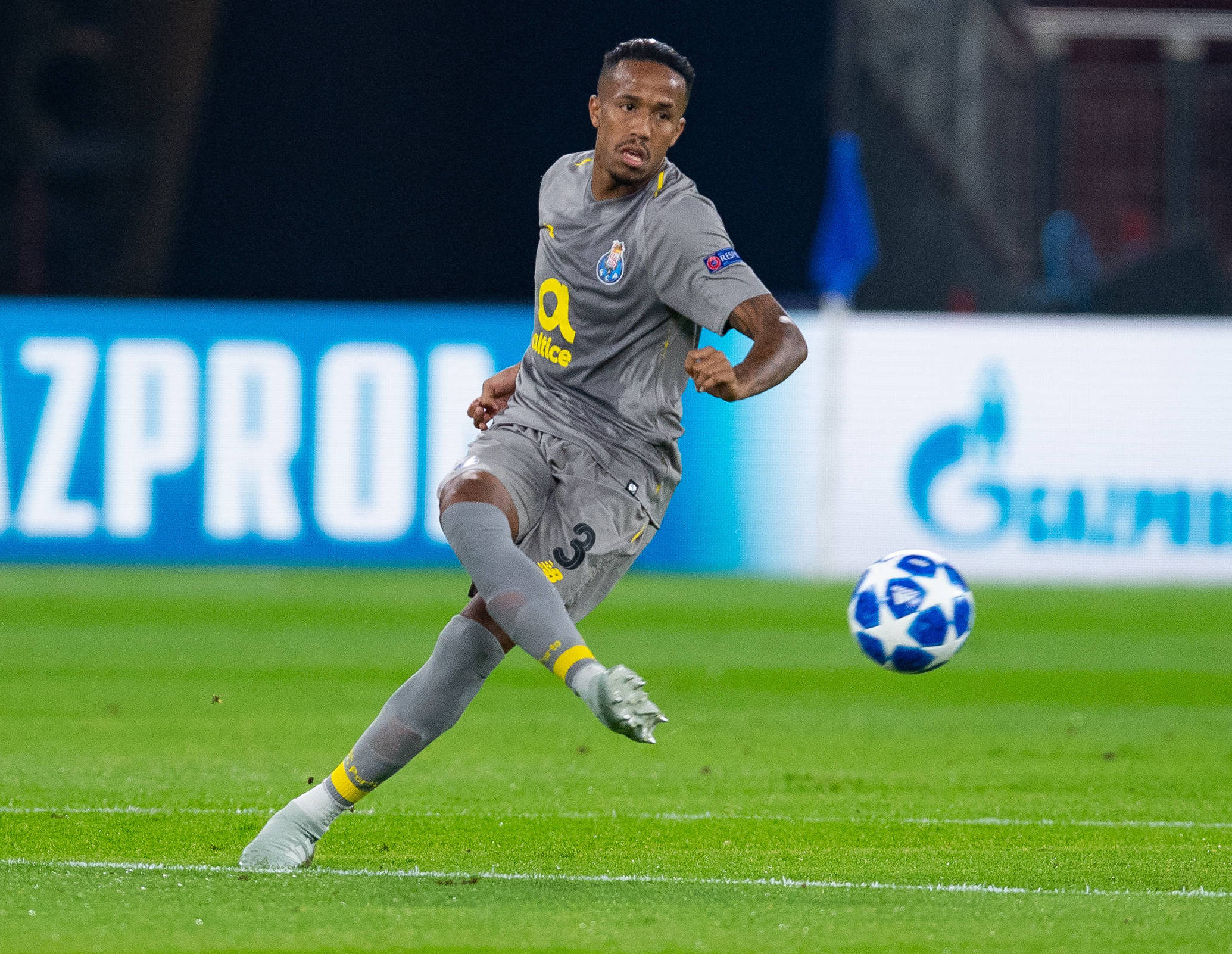It’s been a baptism of fire for Jean-Philippe Gbamin in an Everton jersey. On after 45 minutes on opening day to replace fan favourite André Gomes. Midfield partner Morgan Schneiderlin sent off 30 minutes later. Alongside new partner Tom Davies for the last 20 minutes with 10 men. And to top it off he was a starter this week to partner Gomes against tough Watford duo Abdoulaye Doucouré and Étienne Capoue. And breathe. It’s fair to say a few Evertonians wobbled at JP’s wobbles, particularly in that first game against Crystal Palace. Will the real Gbamin please stand up? We’re here at Statsbomb Towers, so let’s have a look at his radar: 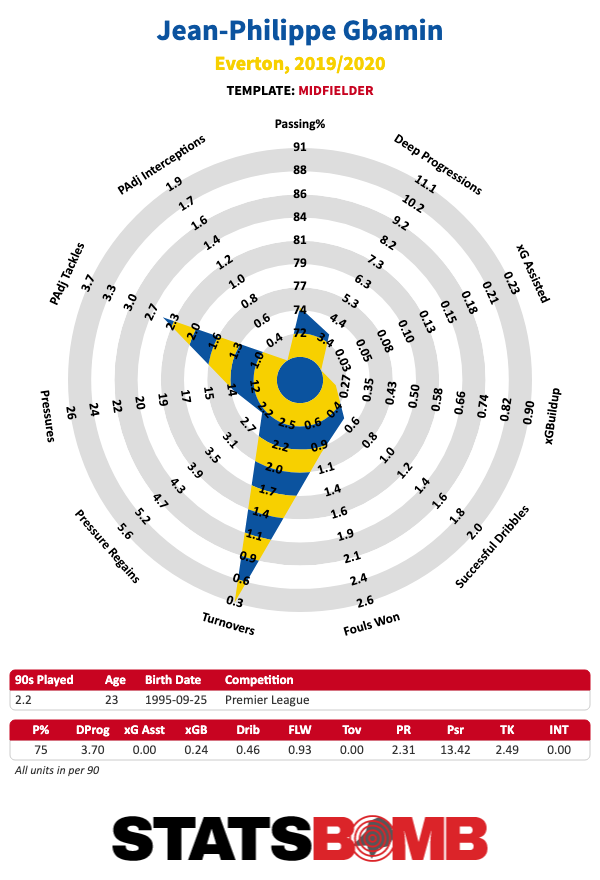 So yeah, moving swiftly on to a comparison with last season’s radar at Mainz. What else is in his locker?
So yeah, moving swiftly on to a comparison with last season’s radar at Mainz. What else is in his locker? 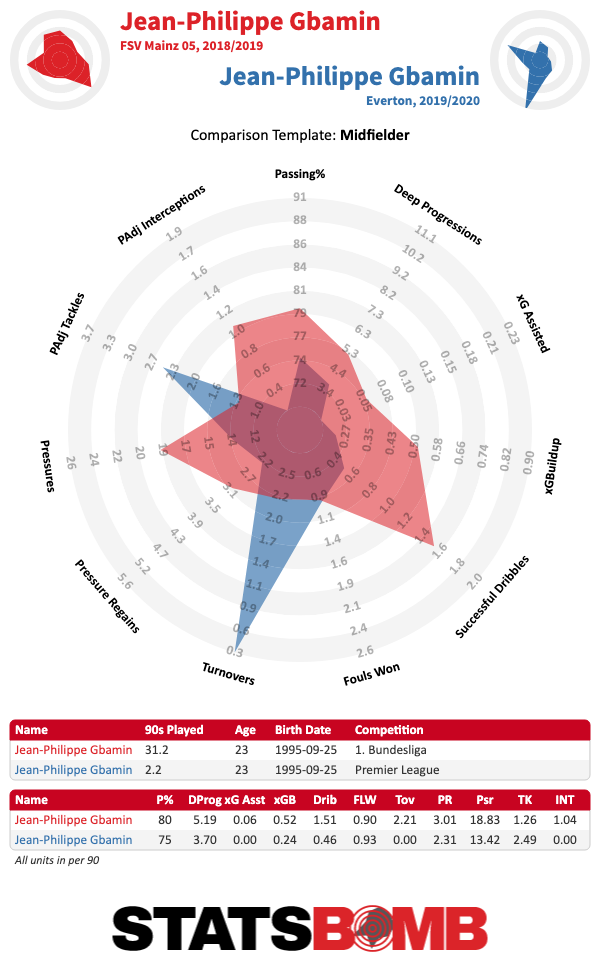 Ok, so still nothing amazing. But extra facets to his game there that we’ve not seen yet in the small sample of 120 minutes so far at Everton. His passing can be better, he can carry the ball nicely, and he can press the ball more. Good. Even though the sample is small, the different aspects of his play on the radar are mirrored in his defensive work at both clubs too. At Everton, he’s mainly stuck to the right-hand side of the pitch:
Ok, so still nothing amazing. But extra facets to his game there that we’ve not seen yet in the small sample of 120 minutes so far at Everton. His passing can be better, he can carry the ball nicely, and he can press the ball more. Good. Even though the sample is small, the different aspects of his play on the radar are mirrored in his defensive work at both clubs too. At Everton, he’s mainly stuck to the right-hand side of the pitch: 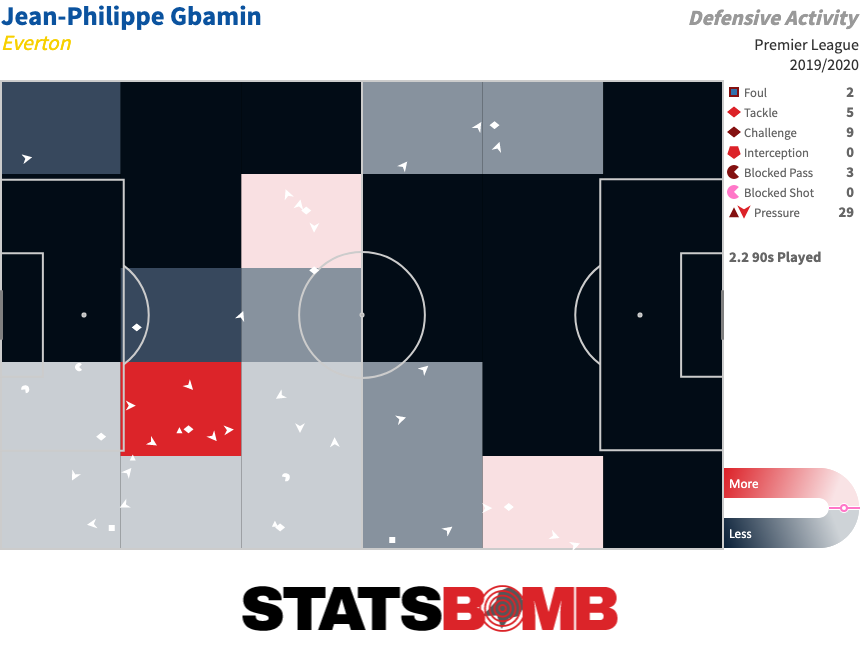 Despite starting nominally on the right side of the pitch at Mainz too, he still found a ton of time to roam the pitch much more freely to disrupt play:
Despite starting nominally on the right side of the pitch at Mainz too, he still found a ton of time to roam the pitch much more freely to disrupt play: 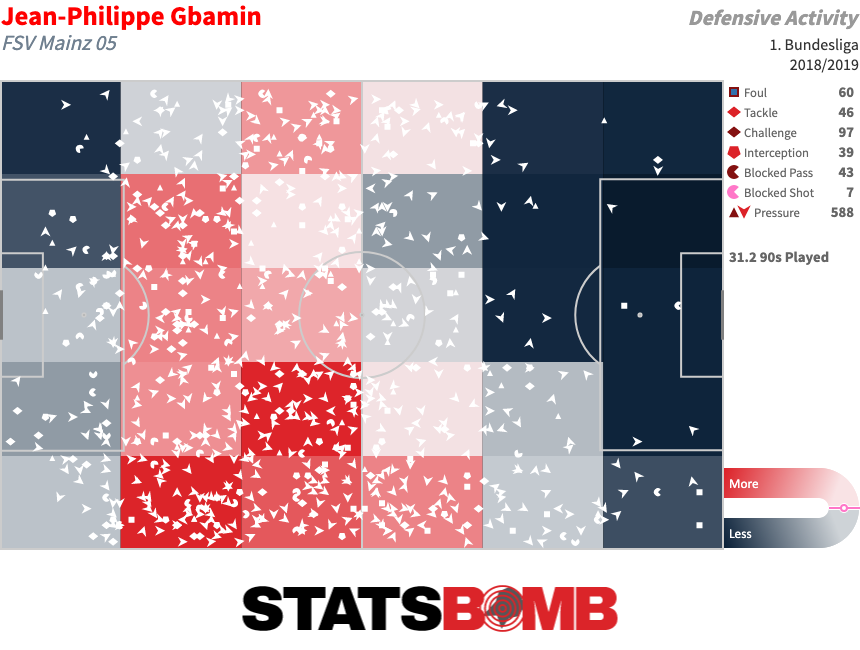 Are we likely to continue to see a more restricted Gbamin in Marco Silva’s line up? His shot map last season in the Bundesliga featured a fair few bombs. Two hit the target:
Are we likely to continue to see a more restricted Gbamin in Marco Silva’s line up? His shot map last season in the Bundesliga featured a fair few bombs. Two hit the target: 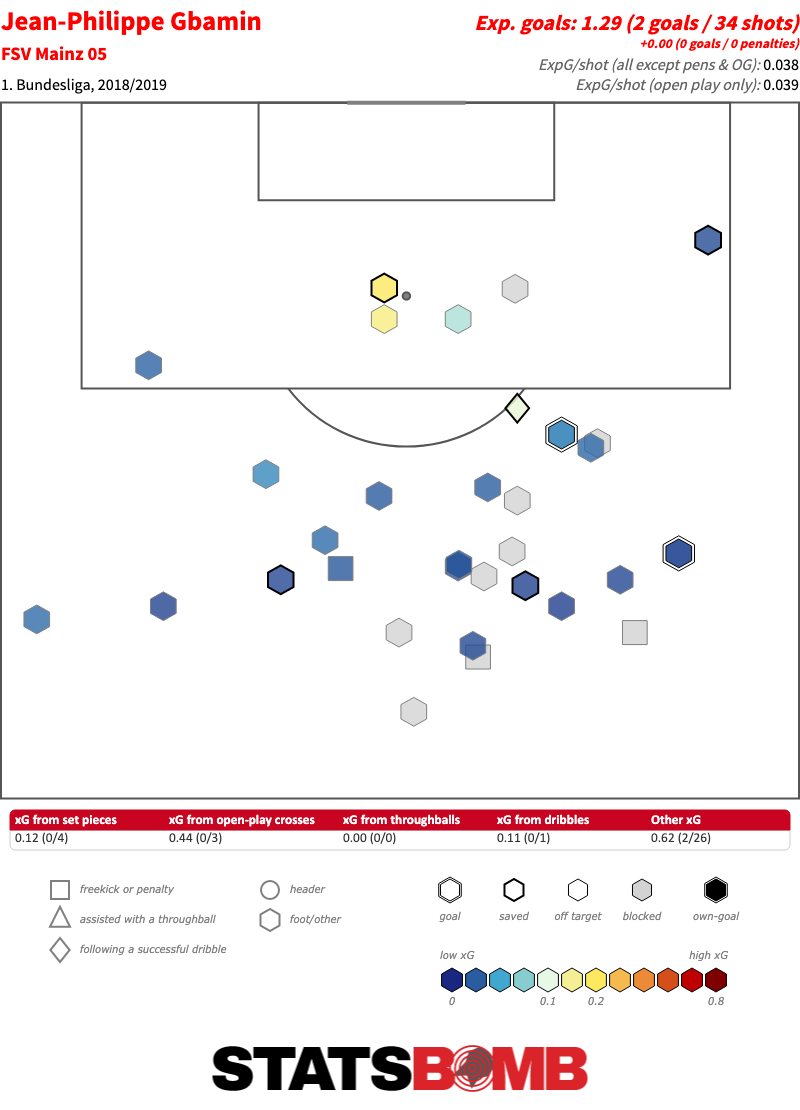 He hasn’t even pulled the trigger yet at Everton… On signing the Ivorian, Silva stated that Gbamin wasn’t a direct replacement for Idrissa Gana Gueye. Yet due to injury and suspension that’s how he’s chosen to play him so far. Can we assume Gbamin was bought so Everton could gradually switch to a three and have Fabian Delph and Gomes in there with him? Personally, I think this would be a forward step to resolving Everton’s attacking issues where Gylfi Sigurðsson either does something wonderful or does nothing at all. An extra Gbamin shaped body in the middle of the park might lead to more control than the team completing just 300 passes against Watford at home. Would this disruption of shape without the Icelander who works so hard to close down opponents at every opportunity ruin Everton’s good defensive numbers? They’re used to playing this system now and The Toffees are grinding out results with it, but will it get Everton where the club need to go? If Silva thinks it is, I was interested to look at what the radars suggest Gbamin and Gomes bring together as a two:
He hasn’t even pulled the trigger yet at Everton… On signing the Ivorian, Silva stated that Gbamin wasn’t a direct replacement for Idrissa Gana Gueye. Yet due to injury and suspension that’s how he’s chosen to play him so far. Can we assume Gbamin was bought so Everton could gradually switch to a three and have Fabian Delph and Gomes in there with him? Personally, I think this would be a forward step to resolving Everton’s attacking issues where Gylfi Sigurðsson either does something wonderful or does nothing at all. An extra Gbamin shaped body in the middle of the park might lead to more control than the team completing just 300 passes against Watford at home. Would this disruption of shape without the Icelander who works so hard to close down opponents at every opportunity ruin Everton’s good defensive numbers? They’re used to playing this system now and The Toffees are grinding out results with it, but will it get Everton where the club need to go? If Silva thinks it is, I was interested to look at what the radars suggest Gbamin and Gomes bring together as a two:  They clearly both bring different things to the team, which is a good, but it just doesn’t look like it’s enough at this point. Stretching play with deep progressions isn’t part of either’s game or seemingly in Silva’s tactical plan. The lovely Statsbomb Tactics IQ dashboard can show us successful passes (red) versus unsuccessful (yellow). Those longer vertical balls just haven’t come off yet for the new boy:
They clearly both bring different things to the team, which is a good, but it just doesn’t look like it’s enough at this point. Stretching play with deep progressions isn’t part of either’s game or seemingly in Silva’s tactical plan. The lovely Statsbomb Tactics IQ dashboard can show us successful passes (red) versus unsuccessful (yellow). Those longer vertical balls just haven’t come off yet for the new boy: 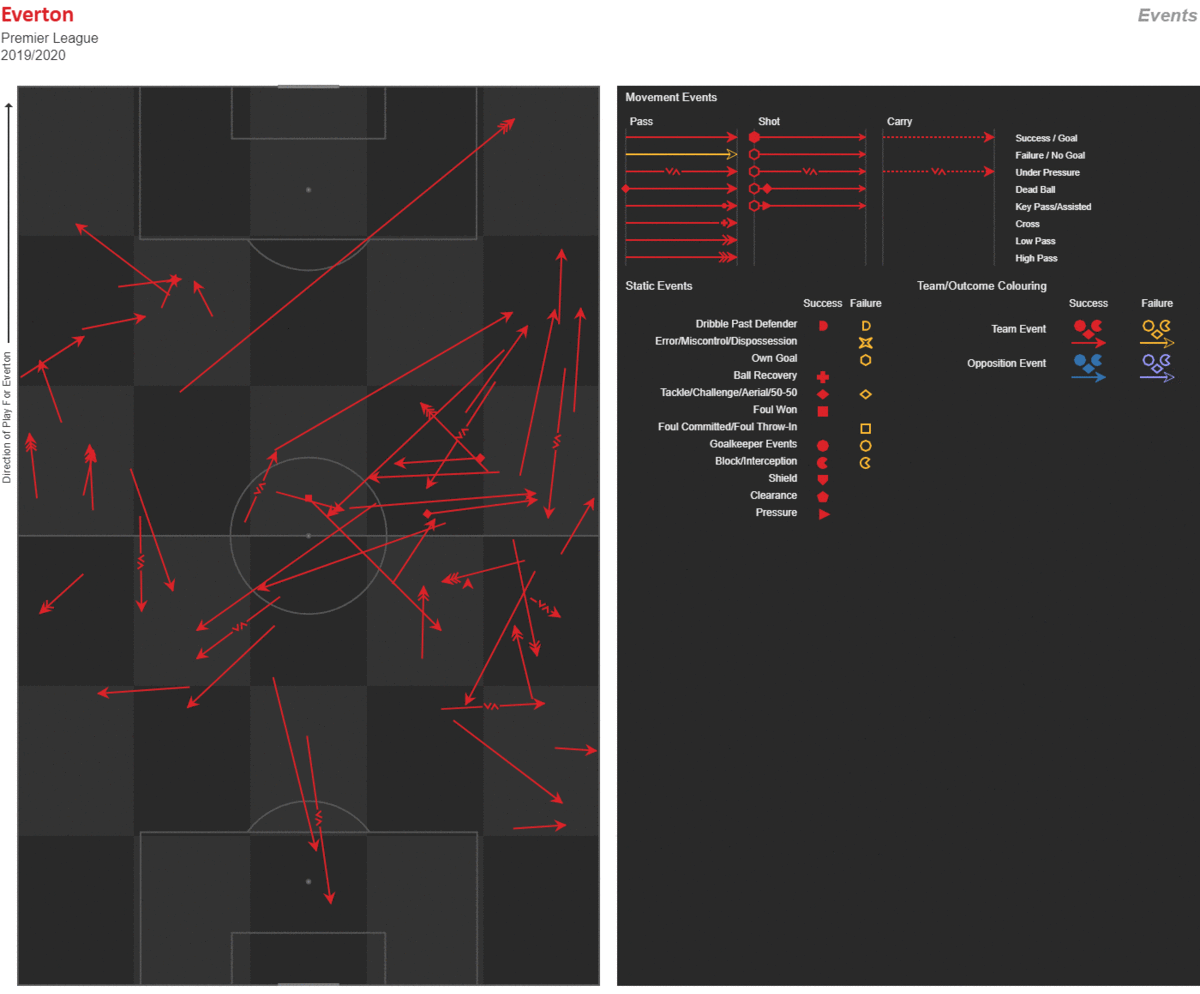 The radar also suggests both are content to sit and hold ground in the middle. The front four do a hell of a lot of the defensive work in front of them. Add in the form of centre back pairing Yerry Mina and Michael Keane and it perhaps explains those good defensive numbers The Blues have right now and showed for most of last season. It’s a safe system. I get the feeling a straitjacket isn’t a look that Gbamin’s particularly keen on. I think he naturally wants to be free. Silva might worry enough to replace him if Delph is back soon from injury. Everton haven’t bought a £25m misfit. He’s just one piece of an expensive jigsaw that isn’t all that easy to put together. The Portuguese may well change it round again for Villa on Friday night.
The radar also suggests both are content to sit and hold ground in the middle. The front four do a hell of a lot of the defensive work in front of them. Add in the form of centre back pairing Yerry Mina and Michael Keane and it perhaps explains those good defensive numbers The Blues have right now and showed for most of last season. It’s a safe system. I get the feeling a straitjacket isn’t a look that Gbamin’s particularly keen on. I think he naturally wants to be free. Silva might worry enough to replace him if Delph is back soon from injury. Everton haven’t bought a £25m misfit. He’s just one piece of an expensive jigsaw that isn’t all that easy to put together. The Portuguese may well change it round again for Villa on Friday night.
Tag: Player Analysis
Ivan Perišić: Bayern's Cross to Bear
If your club has just moved for Ivan Perišić, its transfer window has probably not gone according to plan. That is not exactly a slight against the World Cup finalist. At 30, he’s still a useful winger. It’s just that, well, he’s a winger. And it’s 2019. The story of Bayern Munich’s uninspiring summer loanee from Internazionale actually has very little to do with Perišić; it’s about football’s evolution in recent decades. This, in other words, is an article about crossing. Under Luciano Spalletti, Inter had a cross-heavy attack more commonly associated with relegation-threatened clubs. Over and over, balls were lofted into the box for an isolated Mauro Icardi (or whomever was replacing the striker during one of his periodic fallings out.) In 2018-19, crosses accounted for 32% of the average Serie A club’s passes into the box but 38% of Inter’s. The disparity becomes more glaring if you focus on Perišić. Crosses accounted for 57% of his completed passes into the box. The league average for his fellow attacking midfielders and wingers was less than half that: 27%. To the extent that crossing is still done, it is not really a winger-y skill. At Inter, however, Perišić and fellow winger Matteo Politano led the team in completed crosses. Even on a team that used wingers in this way, Perišić stood out: His 69 completed crosses represented nearly 150% of Politano’s total. Nice? 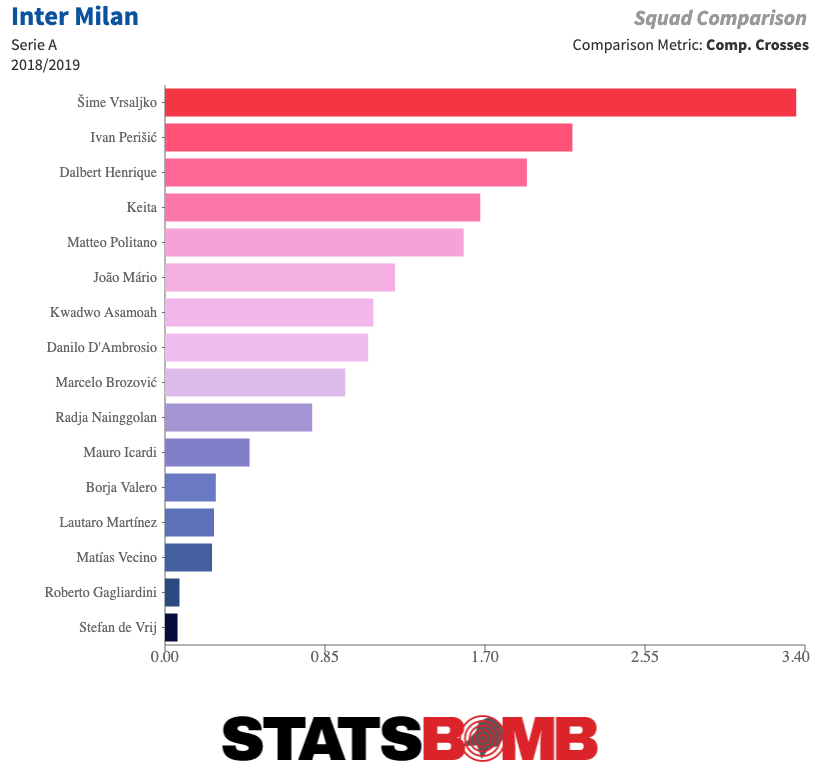 Being good at an efficient task, like converting shots, produces a clear statistical bump; being good at a fundamentally inefficient task, like crossing, produces a statistical muddle. Case in point: Ivan Perišić. He had a middling pass completion percentage and found teammates with a lower percentage of his crosses than thirteen other Inter regulars. This doesn’t mean he was one of the team’s weaker crossers. A winger tasked with chucking the ball into the box ad infinitum will always have a lower completion percentage than occasional crossers. Perišić is a prolific — and good crosser — last season. He just doesn’t have much to show for it.
Being good at an efficient task, like converting shots, produces a clear statistical bump; being good at a fundamentally inefficient task, like crossing, produces a statistical muddle. Case in point: Ivan Perišić. He had a middling pass completion percentage and found teammates with a lower percentage of his crosses than thirteen other Inter regulars. This doesn’t mean he was one of the team’s weaker crossers. A winger tasked with chucking the ball into the box ad infinitum will always have a lower completion percentage than occasional crossers. Perišić is a prolific — and good crosser — last season. He just doesn’t have much to show for it. 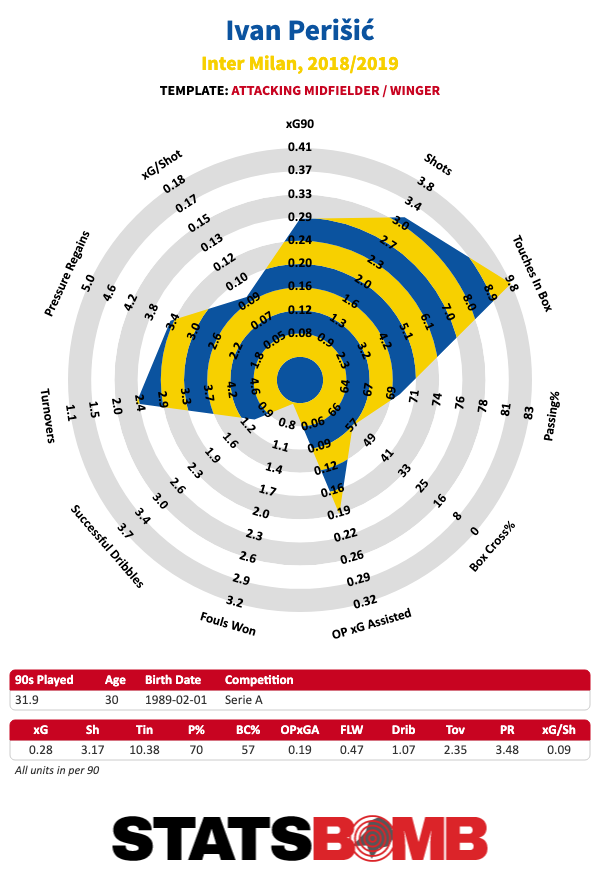 Crossing notwithstanding, Perišić hasn’t been a particularly noteworthy winger. Last season, he couldn’t beat defenders on the dribble or draw fouls. He had lots of touches in the box, but to little effect. He produced a respectable amount of expected goals, but that was largely a function of taking a high volume of low-value shots. (For good measure, Perišić scored fewer goals than expected.) This was a fairly typical season for Ivan. Other than the expected goals underperformance, he had the same season in 2017-18. StatsBomb supremo Ted Knutson found the same general profile in 2016-17. The last time Perišić was a remotely interesting player was in 2011-12 at Borussia Dortmund, when his game still had lots of dribbling and pass completion. Those fun days were a long time ago — an entire career, really. This is not to say that crossing can never produce a tactical advantage. If your club has Cristiano Ronaldo and he has continued to avoid process servers, lofting the ball where only his head can reach it is a serviceable strategy. This might explain why good clubs, after striking out on bigger targets, have so often looked to Perišić. You can talk yourself into his being useful on a dominant club. Jose Mourinho, near the end of his final summer of discontent with Ed Woodward, settled on the idea of Perišić as a crosser for Romelu Lukaku. (In this, Mourinho seemed to have a clearer read on Perišić than Lukaku, who is not actually that kind of big target man.) Similarly, as a key Bayern Munich transfer target saw their legs explode, the club turned to Perišić. Without wishing to be mean, he’s a major step down from Leroy Sané in a bad year:
Crossing notwithstanding, Perišić hasn’t been a particularly noteworthy winger. Last season, he couldn’t beat defenders on the dribble or draw fouls. He had lots of touches in the box, but to little effect. He produced a respectable amount of expected goals, but that was largely a function of taking a high volume of low-value shots. (For good measure, Perišić scored fewer goals than expected.) This was a fairly typical season for Ivan. Other than the expected goals underperformance, he had the same season in 2017-18. StatsBomb supremo Ted Knutson found the same general profile in 2016-17. The last time Perišić was a remotely interesting player was in 2011-12 at Borussia Dortmund, when his game still had lots of dribbling and pass completion. Those fun days were a long time ago — an entire career, really. This is not to say that crossing can never produce a tactical advantage. If your club has Cristiano Ronaldo and he has continued to avoid process servers, lofting the ball where only his head can reach it is a serviceable strategy. This might explain why good clubs, after striking out on bigger targets, have so often looked to Perišić. You can talk yourself into his being useful on a dominant club. Jose Mourinho, near the end of his final summer of discontent with Ed Woodward, settled on the idea of Perišić as a crosser for Romelu Lukaku. (In this, Mourinho seemed to have a clearer read on Perišić than Lukaku, who is not actually that kind of big target man.) Similarly, as a key Bayern Munich transfer target saw their legs explode, the club turned to Perišić. Without wishing to be mean, he’s a major step down from Leroy Sané in a bad year: 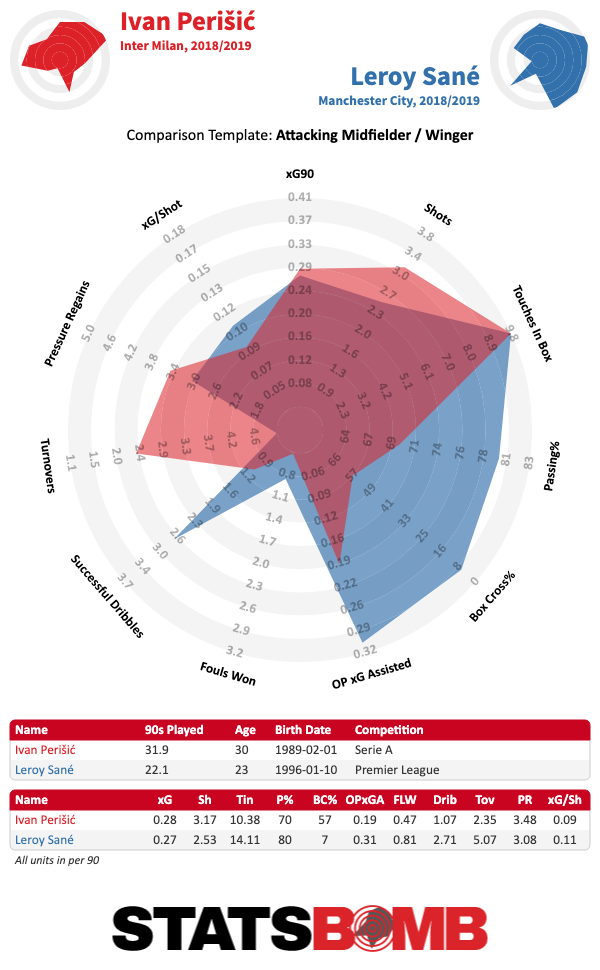 And so Bayern, needing to replace the departed Arjen Robben and Franck Ribéry on the wings, brought Perišić in on loan. To his credit, Perišić's legs have not exploded in the manner of Leroy Sané or Callum Hudson-Odoiï, and he’s nearly a decade older than both players. He plays nothing like Bayern’s other targets, but he’ll eat up minutes on one wing. If you’re feeling generous, you can almost see his crossing for Robert Lewandowski being mildly effectively. Crucially, he was available. This is the beautiful irony of Ivan Perišić: He’s been in high demand in recent years because the thing he’s good at just isn’t that valuable. In an alternate universe, Perišić would have spent the last couple seasons at Everton or maybe Watford, directing high balls at Troy Deeney’s ageing cranium. “Oh Watford,” we’d say. “They’re a little zany.” There is still room for good-but-not-great wingers in the game, but it’s normally at clubs with an outside chance of Europa League qualification. Ivan Perišić, however, has consistently played at and been a target for big clubs even as he ages. It’s nice work if you can get it.
And so Bayern, needing to replace the departed Arjen Robben and Franck Ribéry on the wings, brought Perišić in on loan. To his credit, Perišić's legs have not exploded in the manner of Leroy Sané or Callum Hudson-Odoiï, and he’s nearly a decade older than both players. He plays nothing like Bayern’s other targets, but he’ll eat up minutes on one wing. If you’re feeling generous, you can almost see his crossing for Robert Lewandowski being mildly effectively. Crucially, he was available. This is the beautiful irony of Ivan Perišić: He’s been in high demand in recent years because the thing he’s good at just isn’t that valuable. In an alternate universe, Perišić would have spent the last couple seasons at Everton or maybe Watford, directing high balls at Troy Deeney’s ageing cranium. “Oh Watford,” we’d say. “They’re a little zany.” There is still room for good-but-not-great wingers in the game, but it’s normally at clubs with an outside chance of Europa League qualification. Ivan Perišić, however, has consistently played at and been a target for big clubs even as he ages. It’s nice work if you can get it.
Mason Mount, Player Profile
Mason Mount started in the attacking midfield role for Chelsea in their opening Premier League match, away to Manchester United. That’s quite the vote of confidence for a 20 year-old with no Premier League experience under his belt. So, what kind of player exactly is Mason Mount?
Last year, on loan to Derby, under then Derby now Chelsea, manager Frank Lampard, Mount split his time between attacking midfield, where he spent just over 1000 minutes, and the left side of center midfield where he spent 1773 minutes. This makes a quick look at his outputs tricky. On the whole he definitely doesn’t pop on the midfield radar.
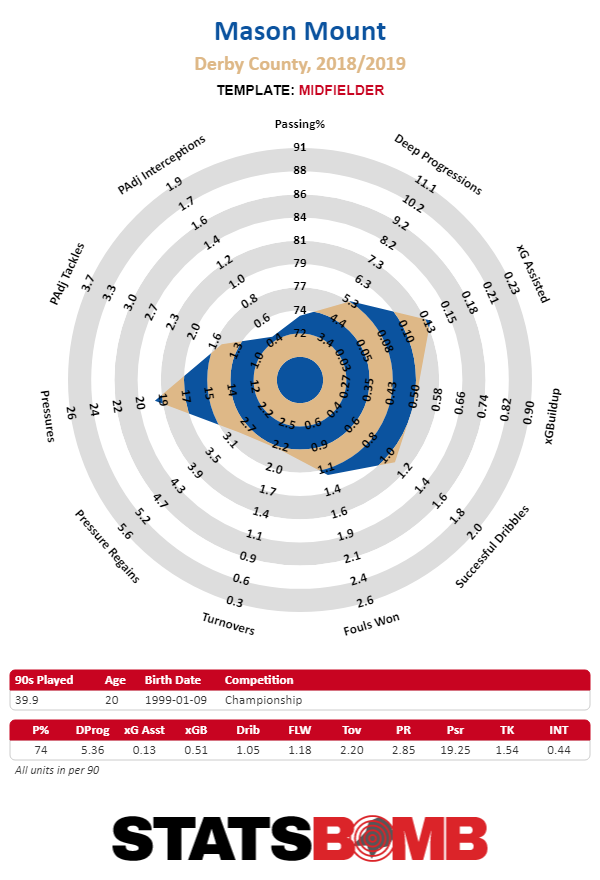
He also doesn’t appear as much above average on the attacking midfielder, though it’s a little more encouraging.
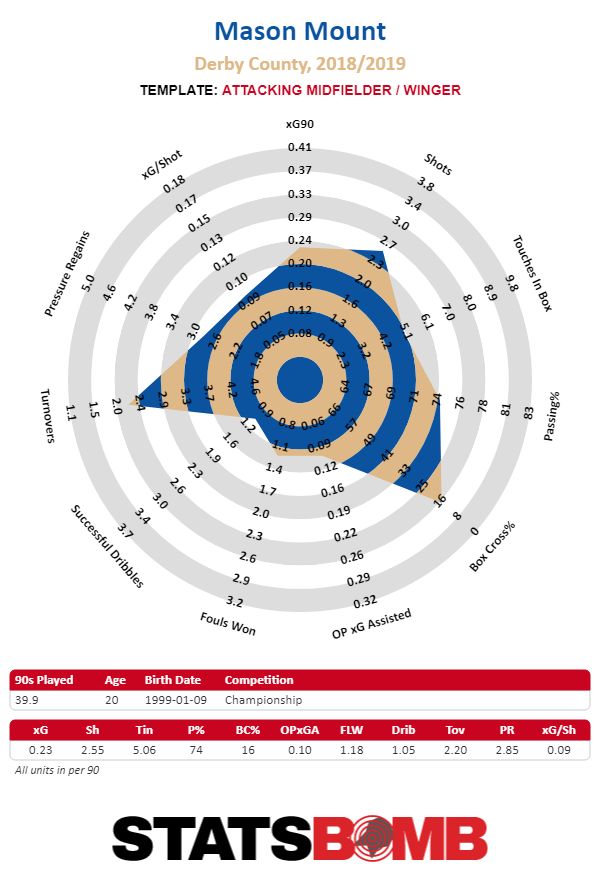
Despite those radars, there are reasons to think that Mount might have a strong future. His nine goals from midfield are encouraging, and fairly reflect his underlying expected goals. While there are a lot of speculative attempts on his shot chart, there are also a good number of efforts with his feet from front and central.
Defensively, his pressure map is also fairly impressive. The fact that he only has an average number of pressures on the midfield radar is actually encouraging given that he spent a third of his time at attacking midfield. And the pressure map picks up the range of his defensive activity.
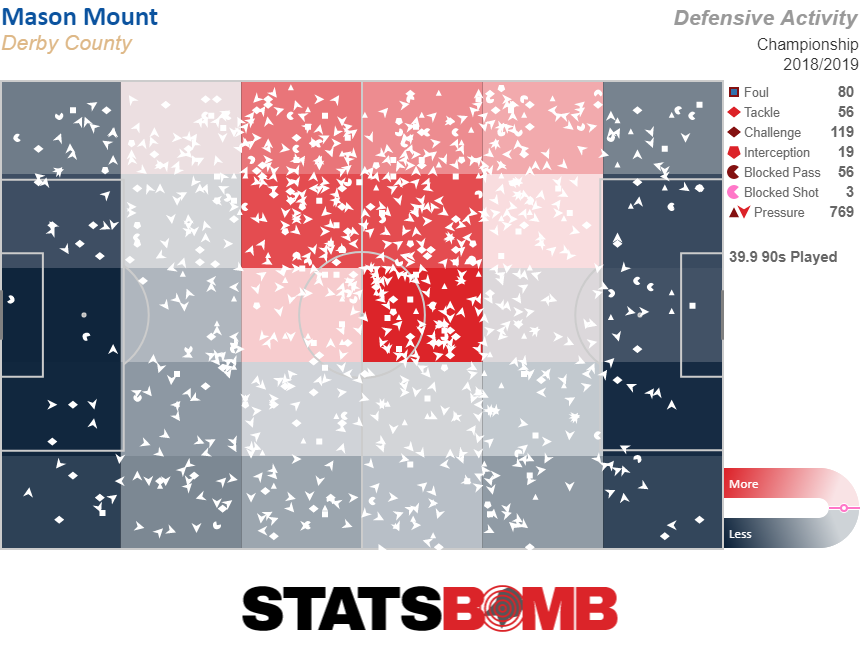
As his career progresses if Mount can either consistently put up the rangy defensive numbers from the attacking midfield spot, or replicate his ability to get into the box if he’s consistently deployed deeper, then there really will be a solid framework to build on.
There is, however, reason to be concerned about his passing ability. He demonstrated neither a particular facility for generating shots for his teammates, nor stood out for moving the ball up the field. His xG assisted for Derby last season was 0.13 per match, fourth on the team. That’s not bad, but it’s not the kind of number that you see in the Championship that makes you think super star in the making. The story of his deep progressions is similar, he was sixth on the team (for players that played more than 1000 minutes). There are all sorts of tactical reasons that this might be the case, but it remains that he has yet to demonstrate at even a Championship level that he is a particularly creative passer. Now he’s being handed the reins at Chelsea. It should be no surprise then that on Sunday he completed exactly one open play pass to striker Tammy Abraham (completed passes are red).
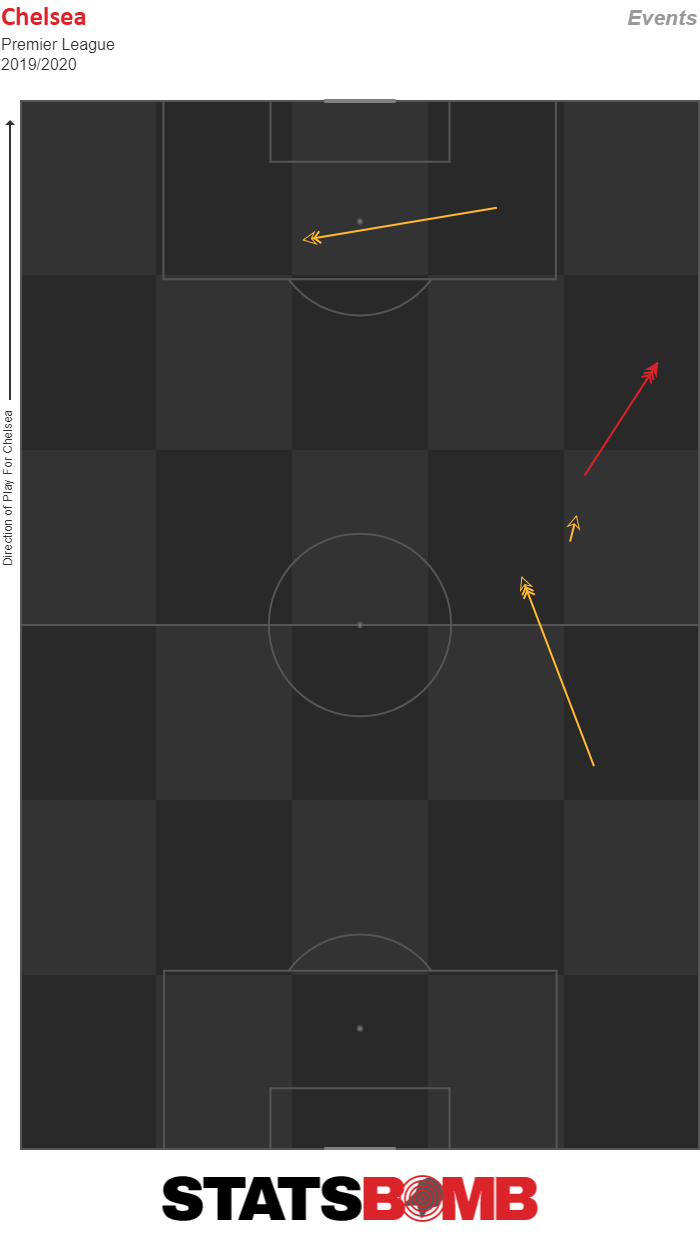
There are definitely things to like about Mount’s game. There are areas where he can legitimately grow and become the kind of star player that every supporter hopes their homegrown talent can blossom into. But, for him to truly become an influential player at the top of the table he’ll have to show some passing ability that he hasn’t yet. If he can add that into the mix then he really might turn into something special.
Moise Kean, Player Profile
News reports suggest Everton are on the verge of acquriring Juventus starlet Moise Kean this week. What can the data tell us about him?
Bare basics tell us he still won’t be 20 years old until next February. He’s played less than 1700 minutes in Serie A during his short career between parent club Juventus and Verona where he went on loan in 2017/18. That’s less than 19 full games to you and me. Not much to go on but he’s packed a fair whack in already.
Everton fans want a goal scorer. Well he’s that. Roughly 9 xG with 10 goals to actually show for it all told. He shoots in decent volume in decent positions. Here’s his shot map for last season at Juventus:
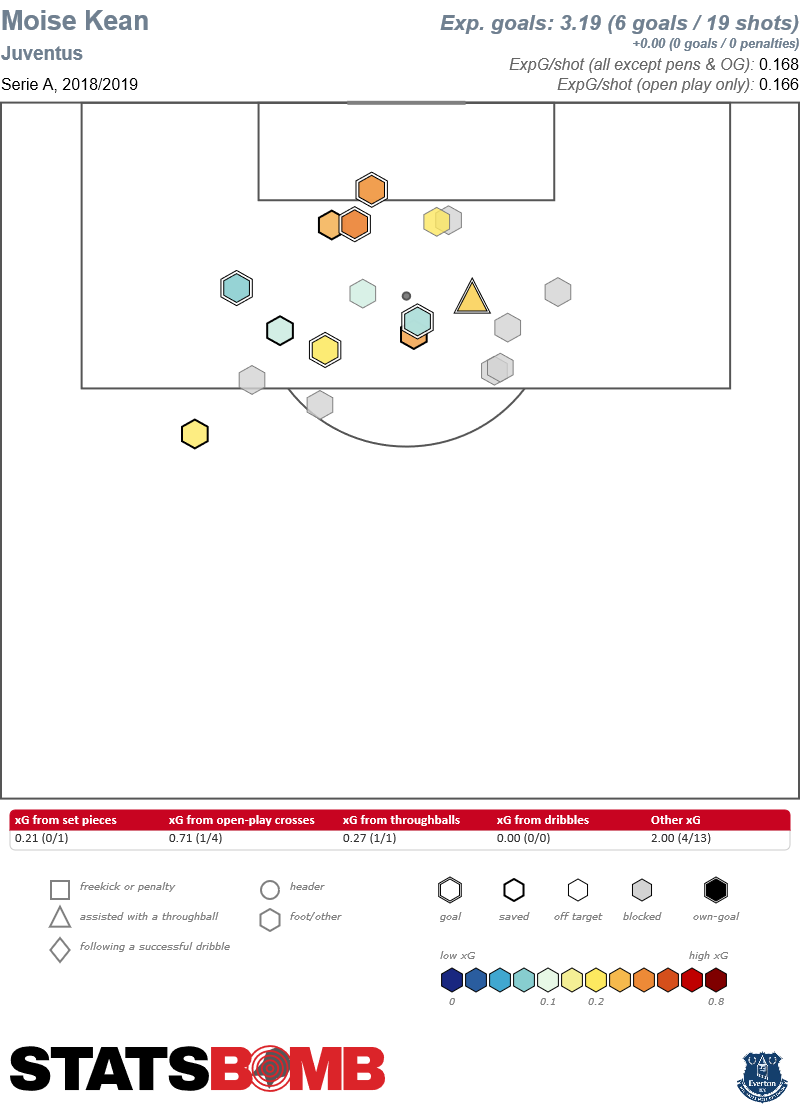
A quick look at his radar shows you that beyond that shooting profile he carries the ball pretty well to beat opponents but beyond that we’re struggling. Moise isn’t one for setting up colleagues, can’t head it, and like Cristiano Ronaldo, left all that boring final third defensive work up to Mario Mandzukic:
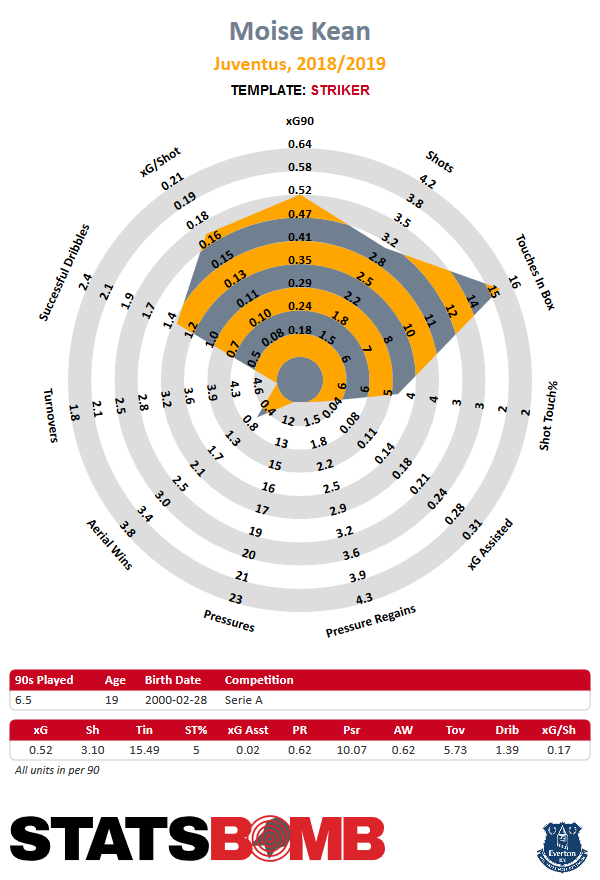
Quite how that sits into Everton’s current forward line is a difficult one. Richarlison, Gylfi Sigurdsson and Dominic Calvert-Lewin all put shifts in when they pull on the blue shirt. The Goodison Park crowd won’t stand for anything else these days and manager Marco Silva’s set-up requires it too.
You also have to consider that Everton’s favourite way of creating chances under Silva is the humble cross – mostly launched from the boots of Lucas Digne and Sigurdsson. Eyes back up to Kean’s shot map. Yep, not one header in there.
It’s also interesting to note that Kean only started getting real game time in March, netted 6 times from then on, but Juventus’s team xG did this:
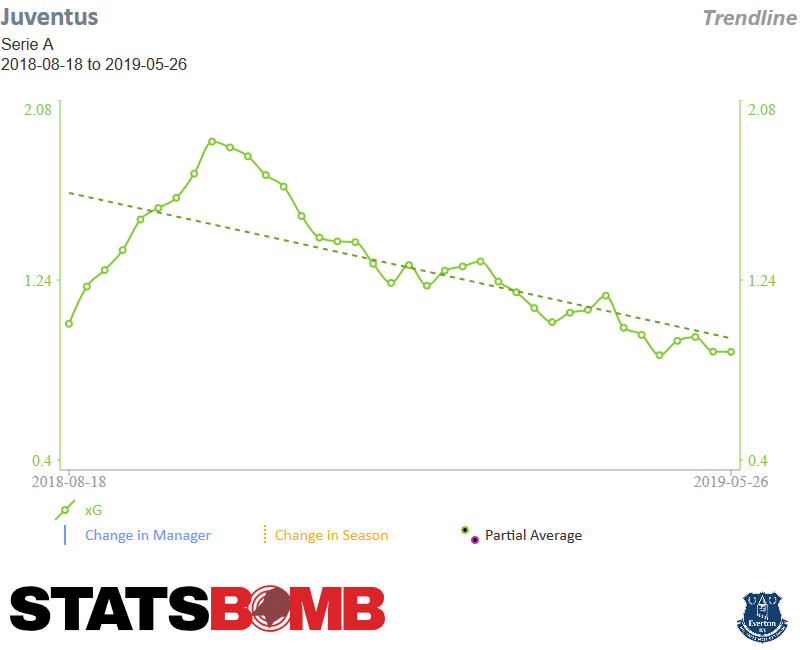
But you want positives, don’t you? I reckon the eyes will give you more of those. Go and have a look at some highlight reels. Kean looks great receiving the ball on the deck with his back to goal. He gets on the half turn very quickly if defenders get too tight. He has two good feet, good close control and good acceleration to get away. His running style with the ball puts me in mind of a Samuel Eto’o/George Weah hybrid. I’ll watch that all day long.
Can the kid score goals? No doubt.
Can the kid play? No doubt.
Is he the right fit for Everton right now? Doubt.
Would I mind if Everton bought him anyway? Doubt.
William Saliba, Player Profile
William Saliba is officially property of Arsenal. The young defender will go on loan back to Saint-Étienne for another season before officially making the move to North London. Here are some basics about what Arsenal can expect from their shiny new center back. First, he’s very very young. At only 18 years old, it’s no surprise that Saliba doesn’t have very many minutes under his belt. Still, he only made 16 league appearances for his club last season, and only played a full 90 minutes on 11 occasions. 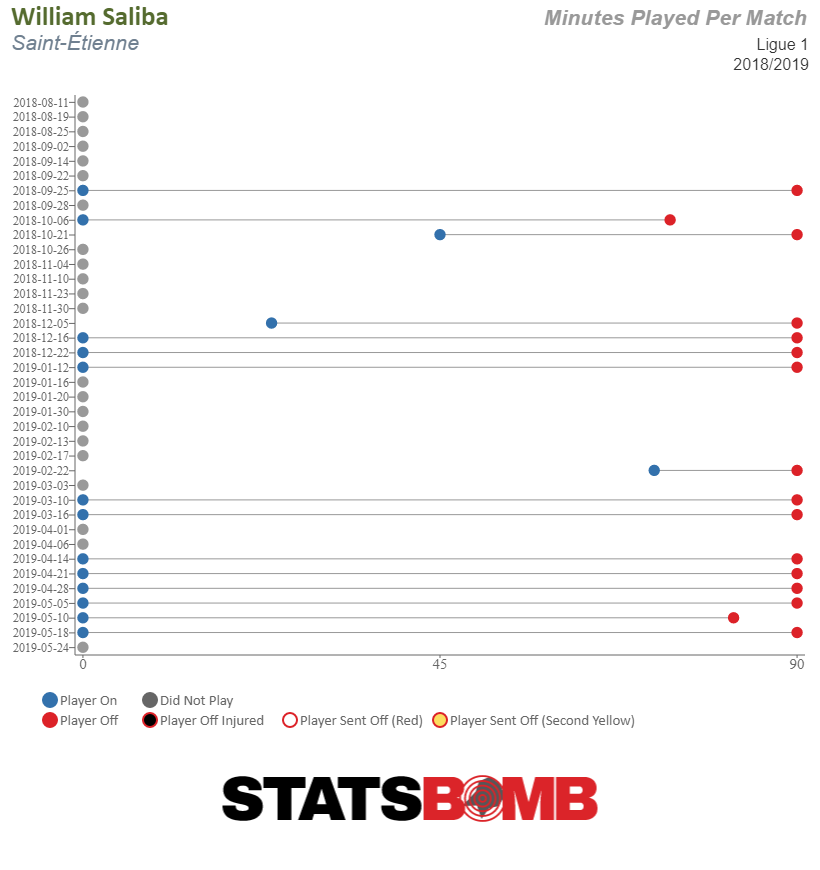 His output when he did play is quite strong. There are, of course, considerable questions about what it means to be a center back who makes a lot of tackles and how that relates to broader team defense, and positional awareness, but Saliba definitely won the ball a lot, 2.5 possession adjusted tackles per 90 minutes, and has an all-around profile with very few statistical weaknesses.
His output when he did play is quite strong. There are, of course, considerable questions about what it means to be a center back who makes a lot of tackles and how that relates to broader team defense, and positional awareness, but Saliba definitely won the ball a lot, 2.5 possession adjusted tackles per 90 minutes, and has an all-around profile with very few statistical weaknesses. 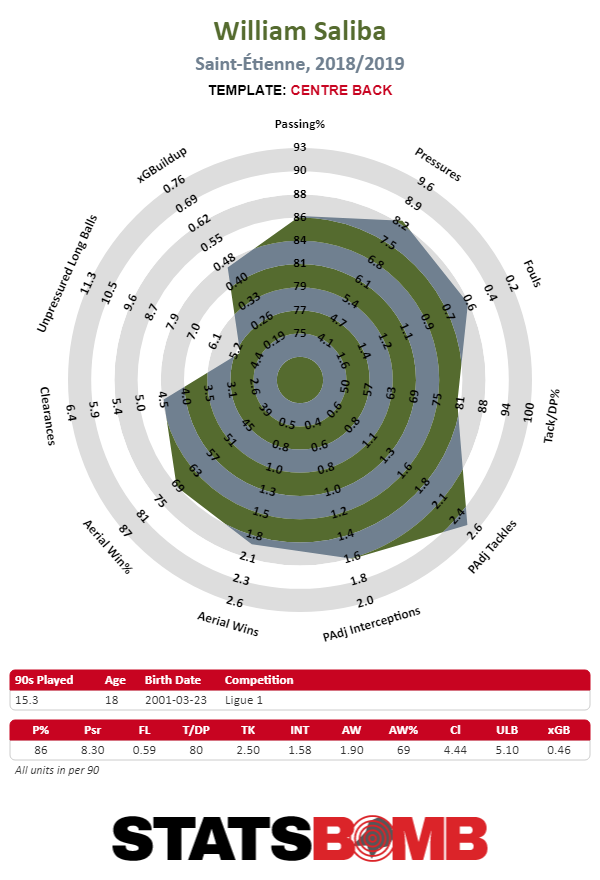 The challenge for Saliba will come when he eventually has to adjust to the different tactical questions that playing for Arsenal will pose, although it’s fair to wonder exactly how different his job will really be. Despite playing in vastly different contexts, top six in England and France but an above average defense in France, as opposed to a bottom half one in England, Arsenal and Saint-Étienne actually have fairly similar outputs.
The challenge for Saliba will come when he eventually has to adjust to the different tactical questions that playing for Arsenal will pose, although it’s fair to wonder exactly how different his job will really be. Despite playing in vastly different contexts, top six in England and France but an above average defense in France, as opposed to a bottom half one in England, Arsenal and Saint-Étienne actually have fairly similar outputs. 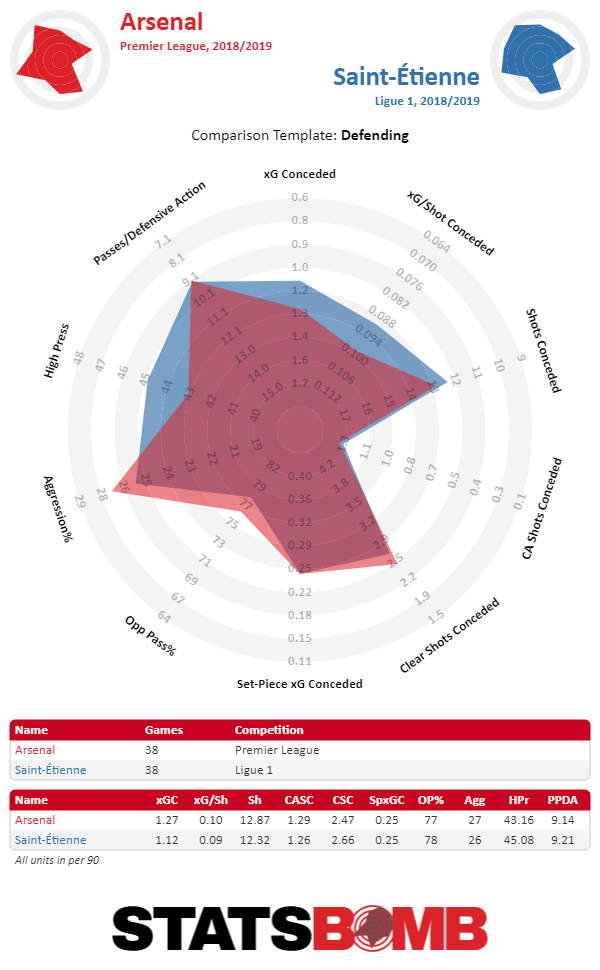 That said, the two teams have chosen to defend very different areas of the pitch. When Arsenal defend high up the pitch, they make their stand primarily in central areas.
That said, the two teams have chosen to defend very different areas of the pitch. When Arsenal defend high up the pitch, they make their stand primarily in central areas. 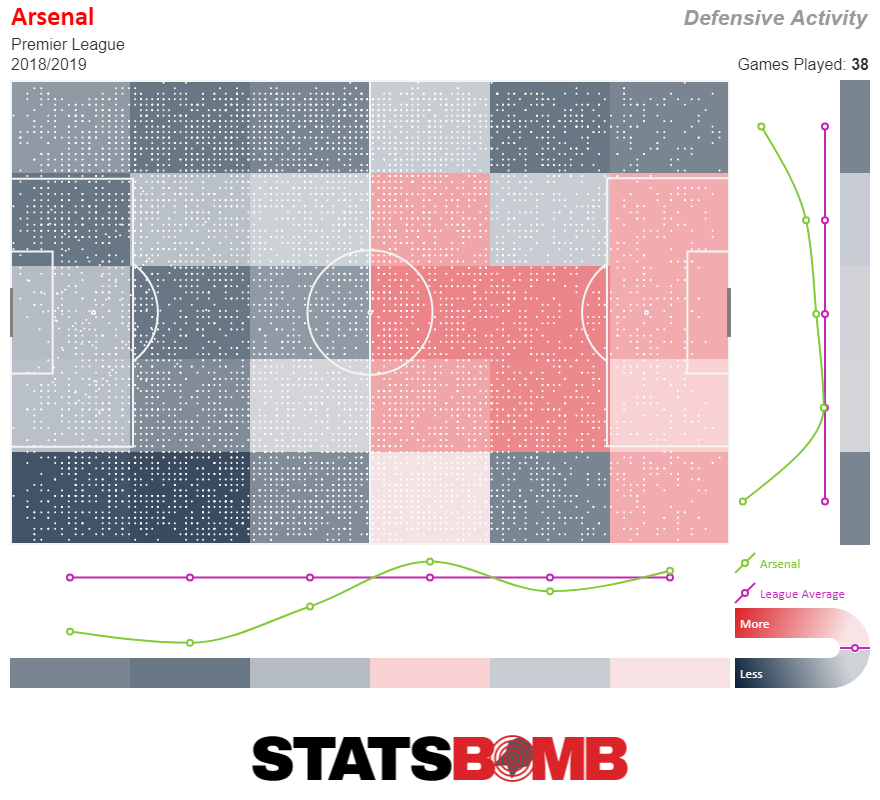 Saint-Étienne press very high and wide, but largely cede the center until the ball is close to their own penalty box.
Saint-Étienne press very high and wide, but largely cede the center until the ball is close to their own penalty box. 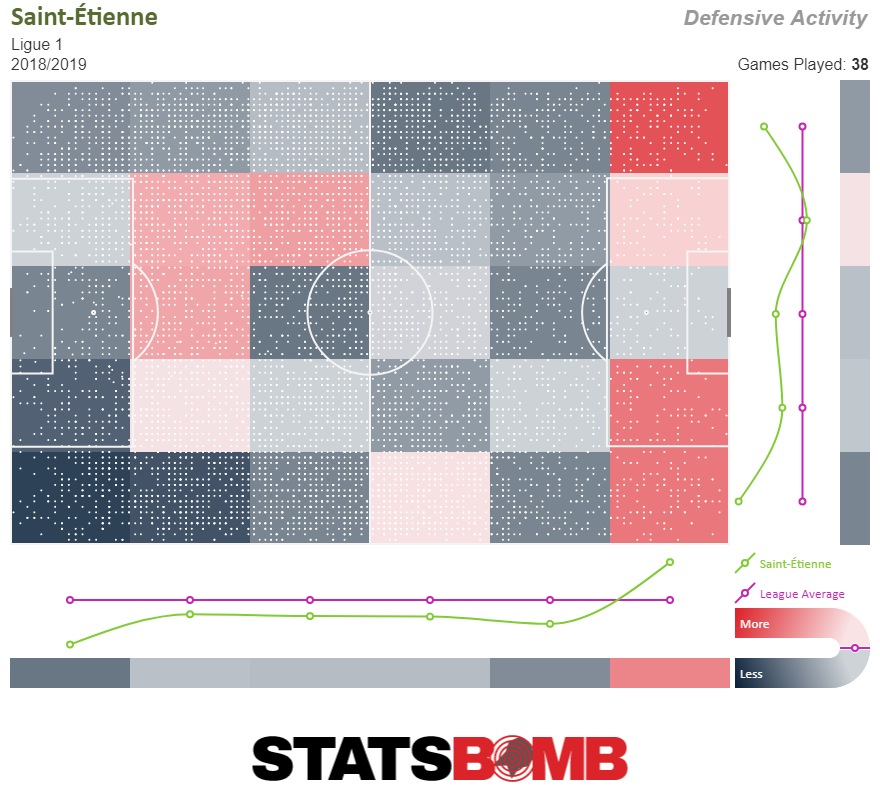 Arsenal are clear getting a very talented, very active center back. He can physical do it all, but that doesn’t mean that when he arrives a year from now, he’ll be ready and able to do it all for Arsenal.
Arsenal are clear getting a very talented, very active center back. He can physical do it all, but that doesn’t mean that when he arrives a year from now, he’ll be ready and able to do it all for Arsenal.
João Félix, Player Profile
Something new that we’re going to try this season here at ye old StatsBomb is to give you some brief profiles of players or teams in the news. In addition to our regular stream of great in-depth content, we want to provide some relevant bite sized nuggets. Today, let’s take a look at the Atletico Madrid’s replacement for Antoine Griezmann, João Félix.
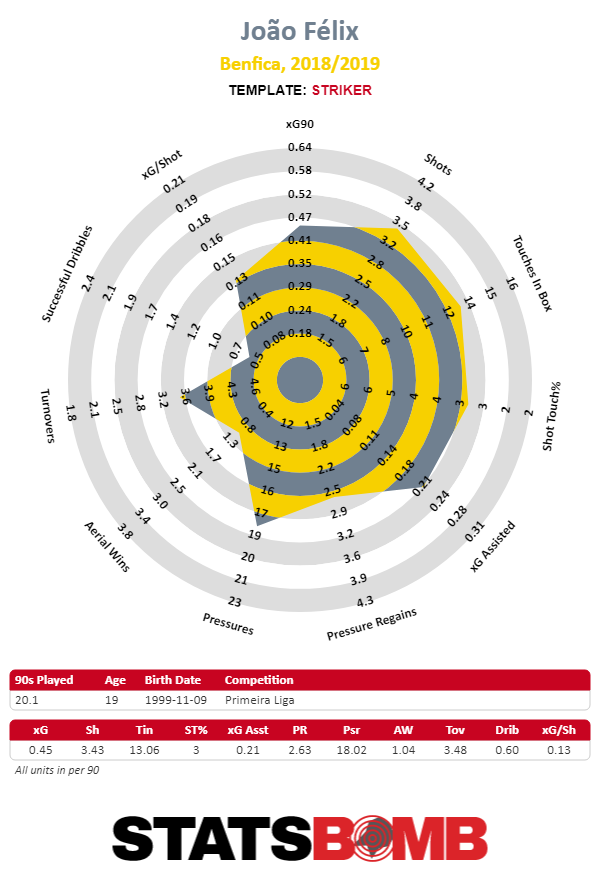
His radar is well rounded, but not particularly impressive along any one particular axis. Considering his extremely young age, 0.45 xG per 90 minutes is certainly impressive, but it’s representative of a striker with potential, not one who is already elite. The mix of 3.43 shots per 90 and 0.13 xG per shot is a fine balance of shot volume and shot quality.
It’s also important to note that João Félix isn’t a one trick goalscoring pony. He supplements his solid shot getting with 0.21 XG assisted per 90. One thing worth noting here is that these numbers were accrued in substantially less than a full season. This isn’t abnormal for a young player. But, he didn’t become a regular league starter until the end of January. The numbers are impressive, but they were established only over roughly half a season.
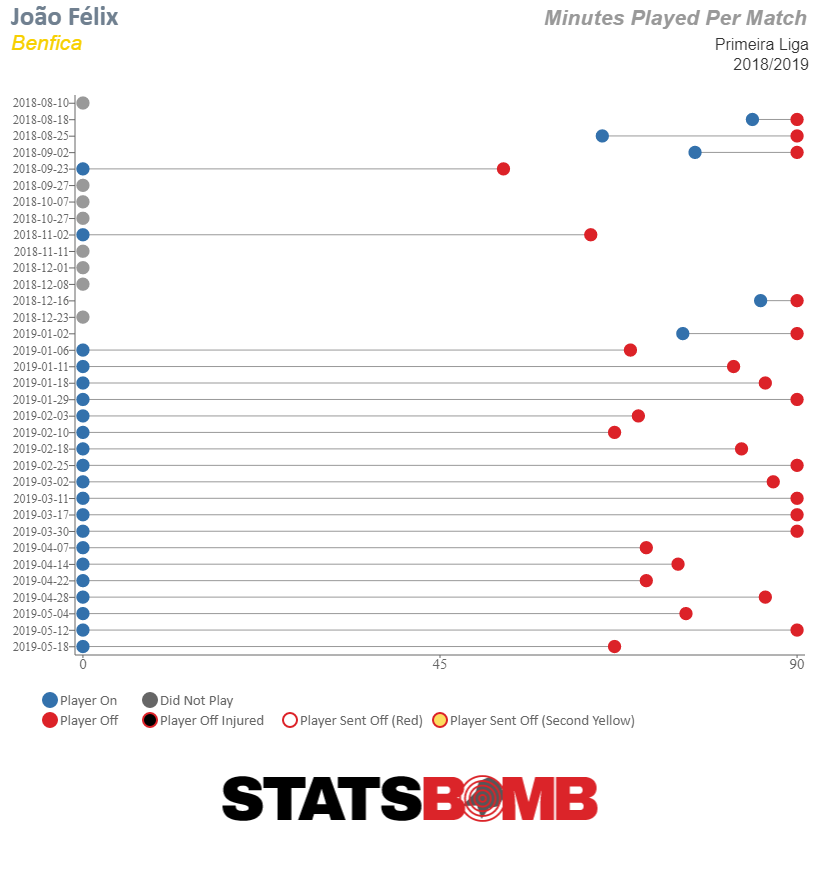
As often happens with talented young prospects who garner a lot of attention, his goal scoring somewhat outran his xG, but the xG numbers themselves are very respectable. Would his price tag have been as high if he scored closer to eight or nine goals instead of 15? It’s possible he’d have moved for less, but those eight or nine goals on their own would themselves be quite impressive.
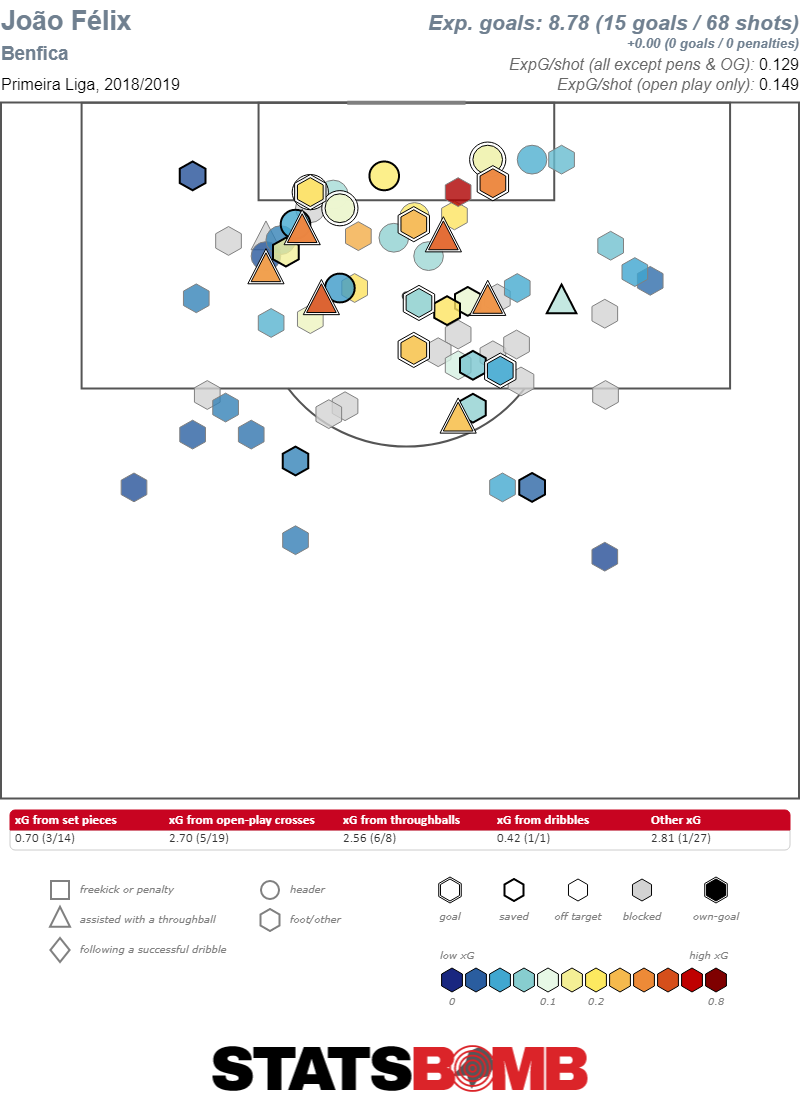
Lastly, and maybe most importantly for Diego Simeone, João Félix is a willing and active defender. He was frequently tasked with covering a wing and gamely did so. Simeone’s system frequently employs two strikers but asks one to drop back and defend a wing, a role which his new young star will be more than equipped to deal with.
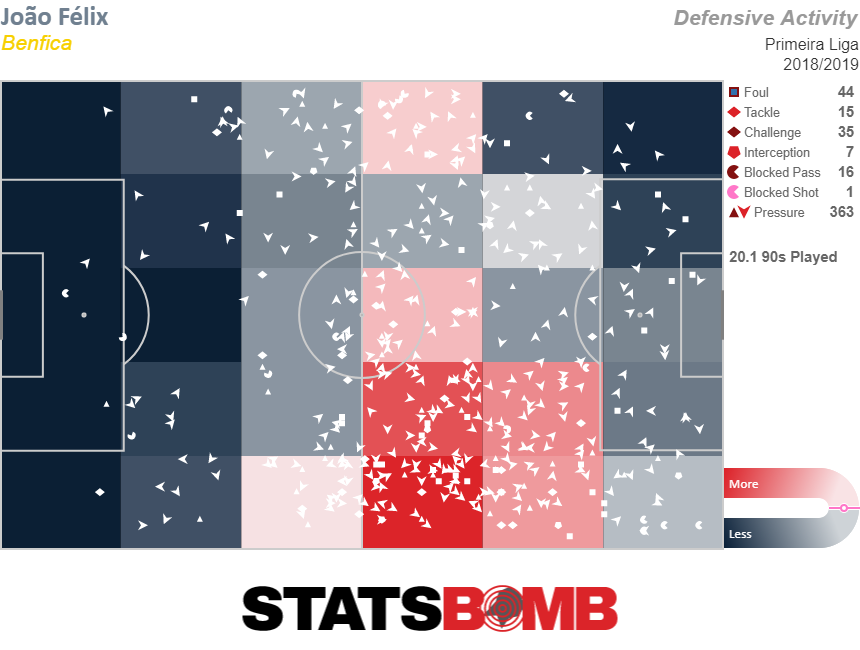
Put it all together and you have a very young, very talented player arriving in Spain even if his goal scoring is slightly misleading. Whether or not his potential ultimately justifies his extremely lofty price tag, there’s a lot to like about João Félix.
Nobody's Lionel Messi, But LAFC's Carlos Vela Sure Is Trying
Bob Bradley, LAFC’s manager, has very specific ideas about how he wants his team to play. He frequently speaks about those ideas at press conferences and constantly communicates them to his team from the touchline. In addition, they are a recurring focus of the ESPN+ docuseries, “We Are LAFC.” While the whole series provides an interesting look at Bradley and LAFC’s expansion season, one particular scene in the first episode is fascinating, given the benefit of hindsight. Discussing his vision for changing his players’ ideas about football, he says, “I’ll talk a lot about Barca, not because they’re the only team in the world, but because there are little things there that can be good examples for us.” Once the team gets on the field, it is apparent that some of the same tactical principles that have been hallmarks at Barcelona have been instilled in the home team at Banc of California Stadium. LAFC want to maintain possession of the ball; as soon as they lose possession, they aggressively press the opponent. 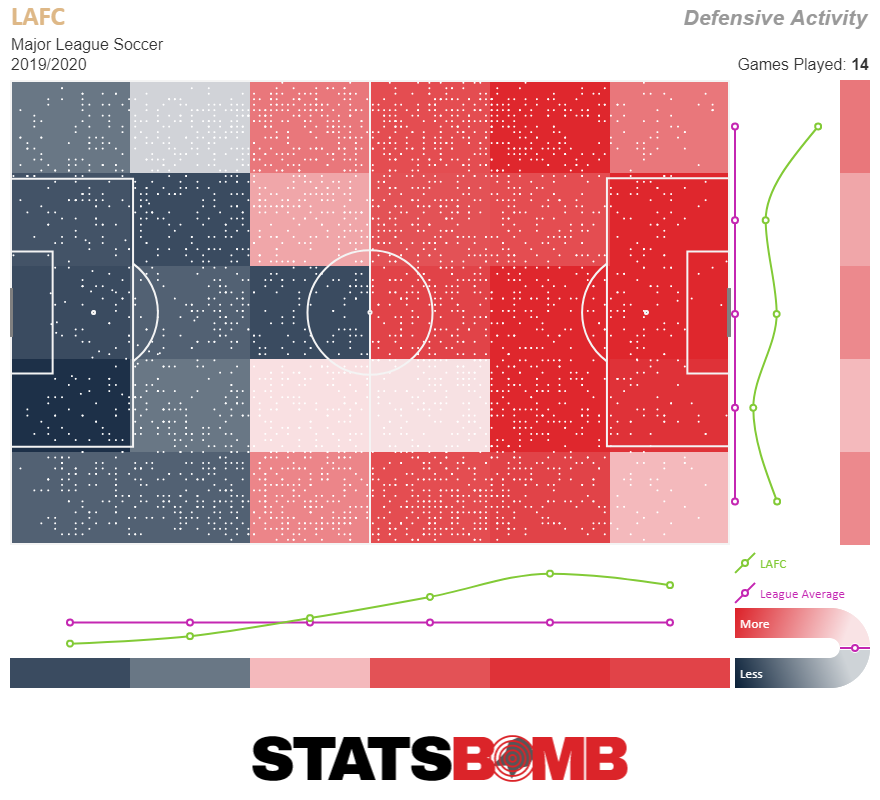 In attack, especially in the final third, Bradley’s side does something else that fans of Barcelona might recognize. The team relies on a talented, left-footed, right winger to produce goals. The Barcelona nugget alone would be of note, given how LAFC have performed in their season and a half, but it’s the next exchange that’s been the story of the season in MLS so far. Bradley recalls his first meeting with Carlos Vela, a meeting which was punctuated with Bradley telling Carlos Vela that he wants him to be as good as Lionel Messi. In the 2018 season, Vela played like a star. He had 14 goals and 10 assists in about 2500 minutes played. While that’s undoubtedly very good, it is not as good as the standard that Messi has consistently set. Not being as good as Messi, of course, is hardly an insult, it’s just every other human being’s reality.
In attack, especially in the final third, Bradley’s side does something else that fans of Barcelona might recognize. The team relies on a talented, left-footed, right winger to produce goals. The Barcelona nugget alone would be of note, given how LAFC have performed in their season and a half, but it’s the next exchange that’s been the story of the season in MLS so far. Bradley recalls his first meeting with Carlos Vela, a meeting which was punctuated with Bradley telling Carlos Vela that he wants him to be as good as Lionel Messi. In the 2018 season, Vela played like a star. He had 14 goals and 10 assists in about 2500 minutes played. While that’s undoubtedly very good, it is not as good as the standard that Messi has consistently set. Not being as good as Messi, of course, is hardly an insult, it’s just every other human being’s reality. 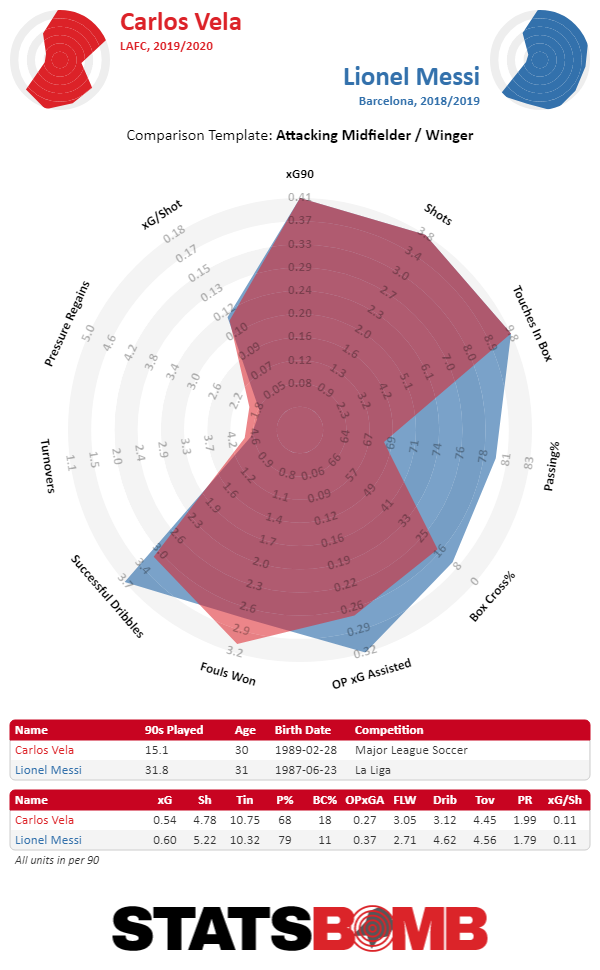 Comparisons, especially those involving a soccer deity, are tricky, so let’s start with some context. La Liga is a much better league than MLS, and Lionel Messi is objectively a much better player than Carlos Vela. That said, Bradley wants his team taking ideas from Barcelona, he’s asking Vela to be as good as Messi, and so far in 2019, Vela is coming closer than you’d expect, and closer than MLS has ever seen. Vela has strung together a superlative season through 14 games, with 13 goals and 5 assists in just under 1300 minutes. For spectators, LAFC games have the same feel of inevitability that Barcelona games do. It’s not if Vela is going to do something spectacular, it’s when. That Vela and Messi share a languid style of play only adds to the parallels. Both look as if they’re calmly navigating the field as the action orbits around them. From just the boxscore numbers, Vela’s 1.22 non-penalty goals and assists per 90 minutes is right behind Messi’s 1.40, but the similarities actually grow when examining the underlying numbers. Vela is also just behind Messi in xG+xA per 90, shots per 90, and key passes per 90, while edging him ever so slightly in xG per shot and fouls won per 90. Vela’s shotmap;
Comparisons, especially those involving a soccer deity, are tricky, so let’s start with some context. La Liga is a much better league than MLS, and Lionel Messi is objectively a much better player than Carlos Vela. That said, Bradley wants his team taking ideas from Barcelona, he’s asking Vela to be as good as Messi, and so far in 2019, Vela is coming closer than you’d expect, and closer than MLS has ever seen. Vela has strung together a superlative season through 14 games, with 13 goals and 5 assists in just under 1300 minutes. For spectators, LAFC games have the same feel of inevitability that Barcelona games do. It’s not if Vela is going to do something spectacular, it’s when. That Vela and Messi share a languid style of play only adds to the parallels. Both look as if they’re calmly navigating the field as the action orbits around them. From just the boxscore numbers, Vela’s 1.22 non-penalty goals and assists per 90 minutes is right behind Messi’s 1.40, but the similarities actually grow when examining the underlying numbers. Vela is also just behind Messi in xG+xA per 90, shots per 90, and key passes per 90, while edging him ever so slightly in xG per shot and fouls won per 90. Vela’s shotmap; 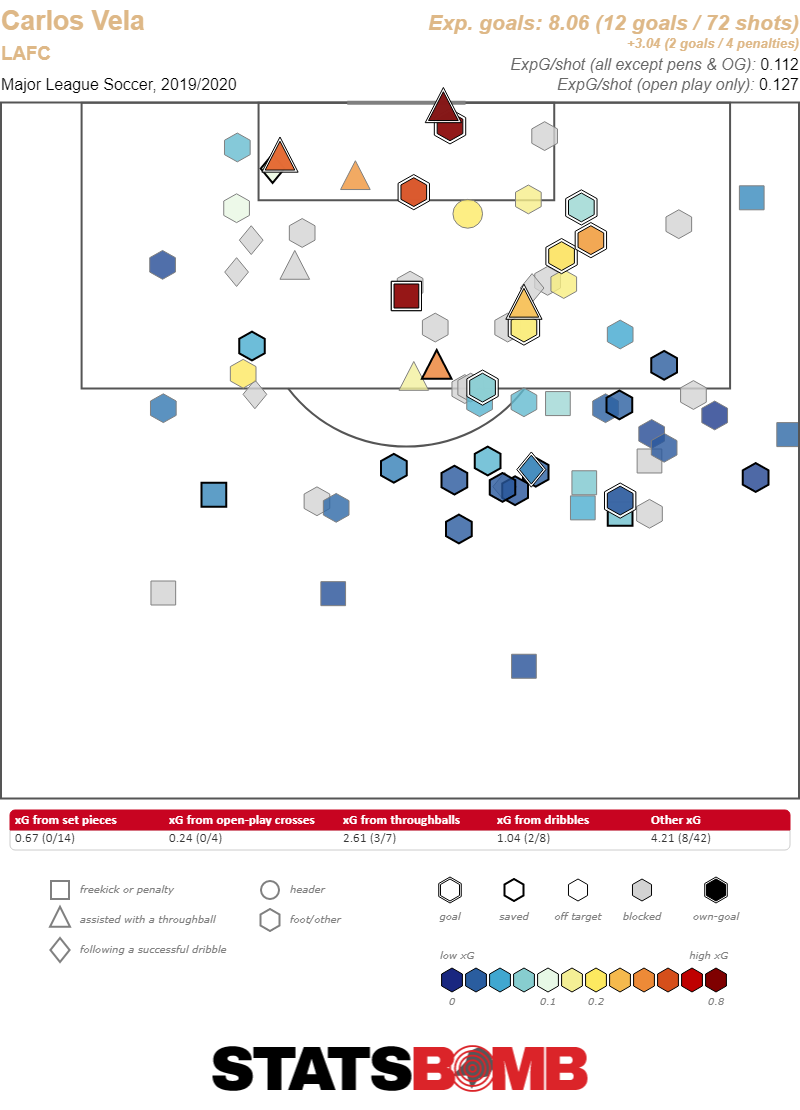 looks like someone cut and pasted a portion (maybe not the best portion, but certainly a portion) of Messi’s map.
looks like someone cut and pasted a portion (maybe not the best portion, but certainly a portion) of Messi’s map. 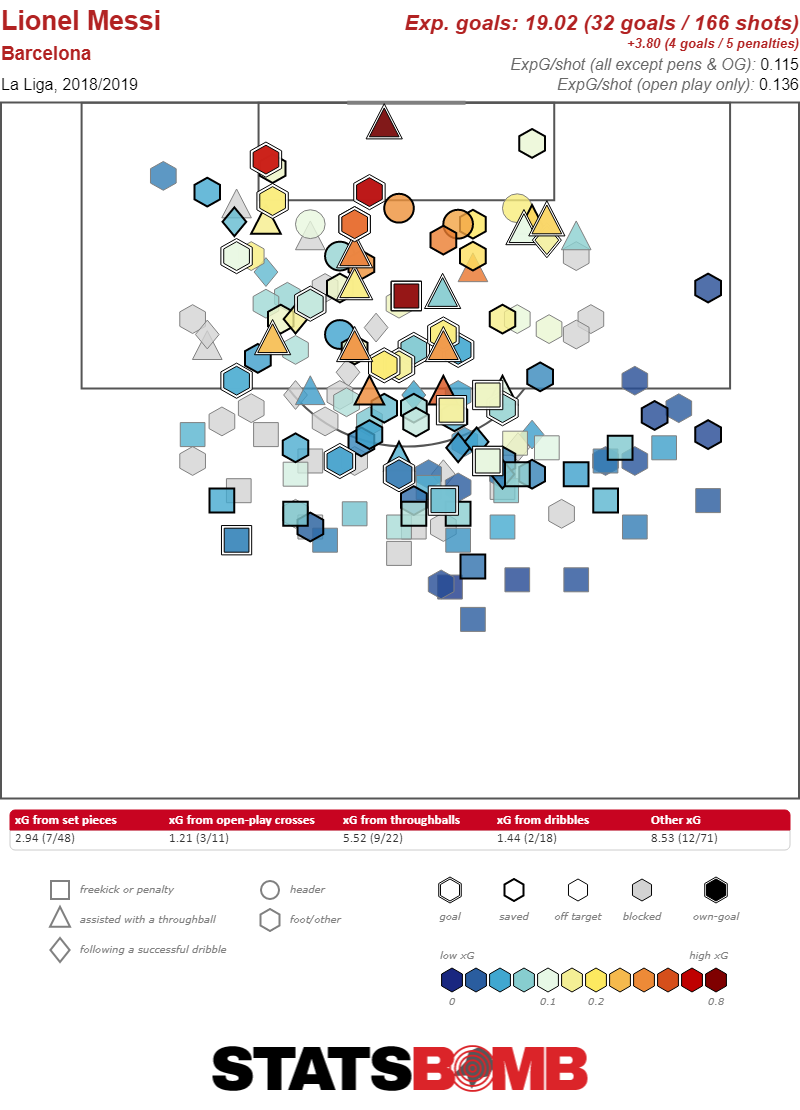 Recently, on 538 Michael Caley wrote about how much Barcelona have relied upon Messi to do everything this season. Vela is carrying a similar load for LAFC. Both players are responsible for at least 40% of their team’s goals while also accounting for at least 20% of their team’s assists, xG, xA, shots, and key passes (though taking out set pieces Vela drops to 17% of key passes while Messi remains above 20%). Their respective workloads also show some of the subtle differences in how they’re deployed. Vela accounts for a much higher portion of LAFC’s touches in the box than Messi does for Barcelona, which can be partially explained by the presence of Luis Suarez. Another possible explanation is that Messi is relied upon for ball progression quite a bit more than Vela has been. Messi contributed 12.4 deep progressions per 90, which accounted for 15% of Barcelona’s total deep progressions. By contrast, Vela is only at 5.9 deep progressions per 90, which accounts for 11% of LAFC’s total. This goes without saying, but the strength of Barcelona is Lionel Messi. He is the single most productive force in modern football, and everything Barcelona does runs through him. He’s their best goal threat, he’s their best creator, and he’s their best ball progressor. Carlos Vela is LAFC’s best goal threat and their best creator, but he’s not close to being their best ball progressor. Three players on the team -- Mark Anthony Kaye, Eduard Atuesta, and Latif Blessing -- have more deep progressions per 90 minutes played than Vela, and they all play central midfield. Those midfielders have been the strength of LAFC. Their ability to apply pressure, and then turn that pressure into transition opportunities for their talented attackers forms the foundation that has allowed Vela to focus his efforts on producing once the ball is in the final third because he doesn't have to worry about getting it there himself. This is, of course, why you can’t actually compare anybody to the legend himself. Vela, is having an amazing season, his attacking output is almost keeping pace, but he’s simply not asked to do an entire aspect of the game which Messi excels at. Vela might look like Messi in attack, but Messi plays midfield at the same time and Vela doesn’t have to. Vela is outperforming expected goals by a wide margin, and his teammates have been marginally better than expected at finishing off chances that he provides. He’s a thirty-year-old who, to this point in the season, hasn’t had to face the same amount of fixture congestion that he will later on. Admittedly, there are reasons to be skeptical of this early run of form from Vela. However, it’s just more fun to believe that Bob Bradley has figured out what makes Vela tick and that someone should have told Vela they want him to be as good as Messi a long time ago.
Recently, on 538 Michael Caley wrote about how much Barcelona have relied upon Messi to do everything this season. Vela is carrying a similar load for LAFC. Both players are responsible for at least 40% of their team’s goals while also accounting for at least 20% of their team’s assists, xG, xA, shots, and key passes (though taking out set pieces Vela drops to 17% of key passes while Messi remains above 20%). Their respective workloads also show some of the subtle differences in how they’re deployed. Vela accounts for a much higher portion of LAFC’s touches in the box than Messi does for Barcelona, which can be partially explained by the presence of Luis Suarez. Another possible explanation is that Messi is relied upon for ball progression quite a bit more than Vela has been. Messi contributed 12.4 deep progressions per 90, which accounted for 15% of Barcelona’s total deep progressions. By contrast, Vela is only at 5.9 deep progressions per 90, which accounts for 11% of LAFC’s total. This goes without saying, but the strength of Barcelona is Lionel Messi. He is the single most productive force in modern football, and everything Barcelona does runs through him. He’s their best goal threat, he’s their best creator, and he’s their best ball progressor. Carlos Vela is LAFC’s best goal threat and their best creator, but he’s not close to being their best ball progressor. Three players on the team -- Mark Anthony Kaye, Eduard Atuesta, and Latif Blessing -- have more deep progressions per 90 minutes played than Vela, and they all play central midfield. Those midfielders have been the strength of LAFC. Their ability to apply pressure, and then turn that pressure into transition opportunities for their talented attackers forms the foundation that has allowed Vela to focus his efforts on producing once the ball is in the final third because he doesn't have to worry about getting it there himself. This is, of course, why you can’t actually compare anybody to the legend himself. Vela, is having an amazing season, his attacking output is almost keeping pace, but he’s simply not asked to do an entire aspect of the game which Messi excels at. Vela might look like Messi in attack, but Messi plays midfield at the same time and Vela doesn’t have to. Vela is outperforming expected goals by a wide margin, and his teammates have been marginally better than expected at finishing off chances that he provides. He’s a thirty-year-old who, to this point in the season, hasn’t had to face the same amount of fixture congestion that he will later on. Admittedly, there are reasons to be skeptical of this early run of form from Vela. However, it’s just more fun to believe that Bob Bradley has figured out what makes Vela tick and that someone should have told Vela they want him to be as good as Messi a long time ago.
Matías Almeyda's Great San Jose Earthquakes Challenge
Matías Almeyda is not afraid of a challenge. He started his coaching career by taking on the immense pressure of leading River Plate back into the Argentinian top flight following the first relegation in their history; next, he inherited a relegated Banfield side; then, he confronted the task of reawakening a giant in the form of Mexican club Chivas.
So far at least, he has also proved capable of rising to them. He achieved promotions at the first time of asking at both River and Banfield, and then produced a series of triumphs at Chivas, twice winning the Copa MX, delivering their first league title since 2006 and finally going all the way in the CONCACAF Champions League in what was to be his farewell to the team.
But even by his standards, his decision to join the San Jose Earthquakes was a bold one. The team finished bottom of the MLS standings in 2018, recording just four victories alongside nine draws and 21 defeats, and have made the playoffs in just two of the last 10 seasons.
Immediately, though, the vibes coming out of pre-season were positive. “We’ve trained really, really hard,” midfielder Magnus Eriksson explained in February. “There’s a new philosophy, and we believe in it. It’s a lot of changes from last year in the way we play, but everything is positive.” That counted for little when San Jose lost their first four matches of the season by a combined score of 14-2, but things have got a lot better since, with a subsequent record of three wins, two draws and two defeats raising hopes for a decent campaign.
Almeyda’s plan for revitalising the Earthquakes revolves around the implementation of an entirely different tactical framework to the one that they used last season. “Our scheme involves everyone playing and everyone running,” Almeyda told MLSSoccer.com last week. “Everyone is committed and whoever is not committed is left to be exposed.”
“Marcelo Bielsa is probably the coach who has influenced him the most,” explains Lucas Marinelli, author of La Estrategia de Almeyda, a book that breaks down Almeyda’s approach. “Due to the constant pressing, the use of wingers, the high-tempo impressed on most attacks, and the positional rotations. I do see an evolution through Almeyda’s career, but those main characteristics have been the same throughout.”
In San Jose, the most outwardly evident change has been the degree to which the Earthquakes seek to press and disrupt opposition build-up play. Last season, they were one of the most passive teams in MLS, allowing 13.88 opposition passes per defensive action.
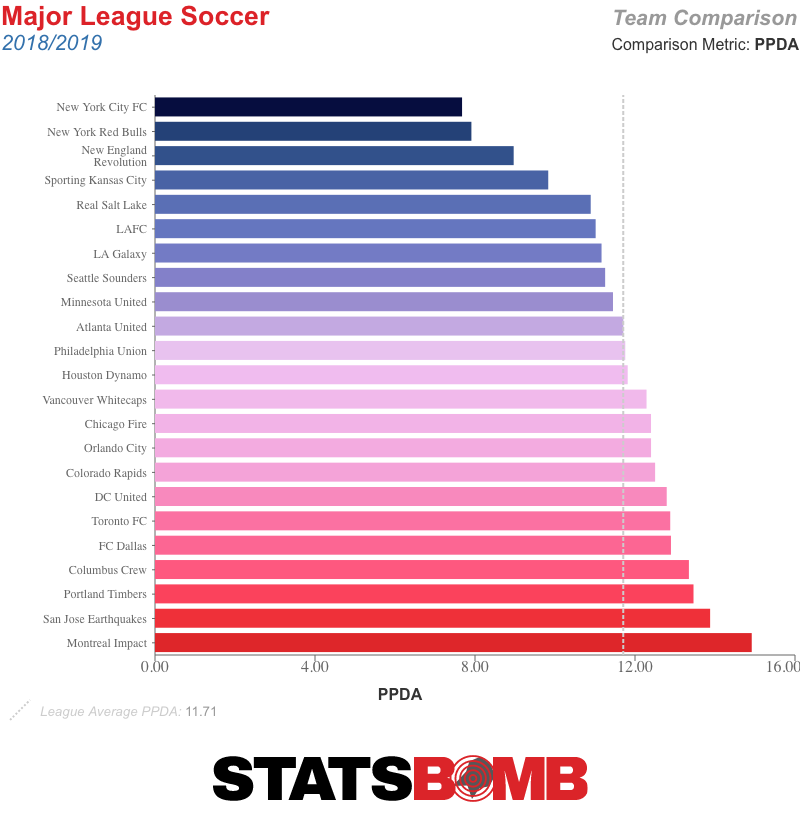
This season, they are one of the most aggressive, allowing just 7.81 opposition passes per defensive action.
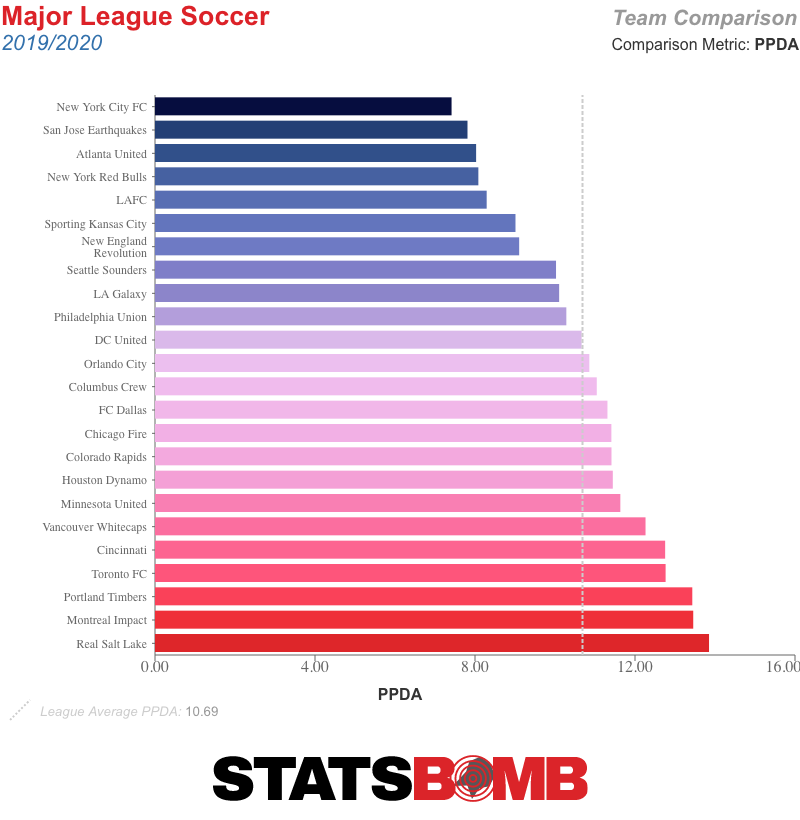
As Marinelli explains, it isn’t always the case that Almeyda’s sides press high up the pitch. San Jose are pretty middle of the road in MLS in terms of how far from their own goal they perform their average defensive action. But once their opponents reach the point at which the press is scheduled to begin, the commitment with which they charge down the ball and hassle receivers is impressive to see. Their predominantly man-marking scheme sees players regularly stepping out of position in pursuit of their men, lending the system a somewhat chaotic look at times.
In the below clip, it is the right central defender Harold Cummings (number 31) who can be seen following the Seattle wide-forward Jordan Morris (13) back towards the centre circle and then swiping at the ball when Kim Kee-hee (20) takes a heavy touch into his reach.
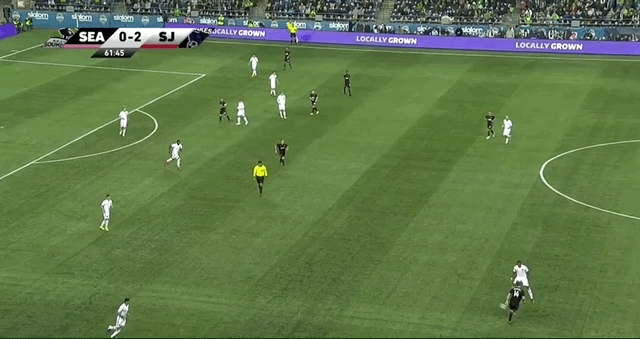
Learning the specifics of this pressing system and being able to put it into action has been one of the key challenges for the squad since Almeyda’s arrival. The hardest part “is understanding exactly when to follow guys and when to switch,” midfielder turned full-back Tommy Thompson recently told The Athletic. “It’s a delicate balance of making sure you stay with your guy, but then if your guy is going all over the field, you can’t just follow him.”
But it isn’t just in defence that the group has had new ideas to take on board. San Jose are also attacking in a different manner this season, with more of a focus on possession. “In his beginnings at River, Almeyda used to play a fast-tempo, really vertical game, without playing the ball out from the back and looking to get it wide as quickly as possible so that the wingers could win individual duels,” Marinelli. “It was at Banfield that he adopted the possession style. The team played out from the back more and built attacks from their own goal. At Chivas, it was kind of a higher level of that style.”
The Earthquakes’ possession share has gone up from 48% last season to 55% this time around, and they are completing over 35% more passes per match than they did previously. That focus on playing short out of defence is demonstrated by the decrease in their average goalkeeper pass length, from 46.60 metres last season to 35.78 this season -- from the sixth longest in MLS to the fourth shortest. There is clearly a learning curve associated with the implementation of such a style, and there have been occasions during their matches to date when that has been painfully clear.
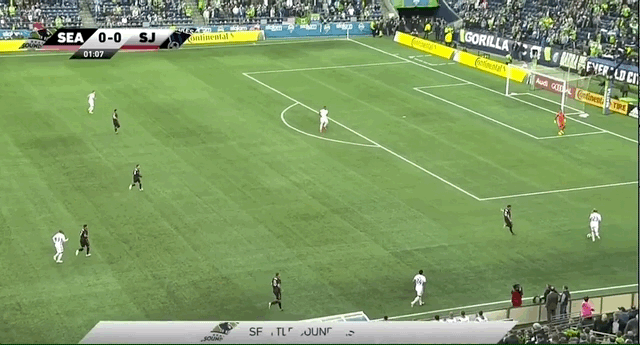
Although Almeyda has changed the manner in which his teams work the ball forward as his coaching career has progressed, one thing has remained constant. “He wants his teams to use a lot of width, and wingers are a usual thing in his formations,” Marinelli explains. “He likes them to be vertical and dangerous in one-on-one situations, so that they are able to beat their markers or create interior spaces for the midfielders to profit from.”
On the right hand side, Cristian Espinoza, a loan signing from Spanish side Villarreal, certainly fits the bill. Of all those who have seen at least 600 minutes of action, he leads the team with 2.04 successful dribbles per 90 and often helps create space for the right-back, usually Thompson, to overlap outside or inside of him depending on which way he goes. His role is primarily creative. He leads the team in both xG assisted and passes into the box per 90, even though he is also the team’s second most frequent shooter, with 2.43 shots per 90.
On the left of the team’s normal 4-2-3-1 formation, Shea Salinas has a divergent role. On that side, it is usually left-back Nick Lima who provides the attacking width. Salinas is generally positioned further upfield and infield than Espinoza. Aside from primary striker Danny Hoesen, no one touches the ball inside the area more often than Salinas (6.35 touches inside the box per 90 versus 3.49 for Espinoza). While he only gets off just over a shot and a half per 90, they are of excellent, albeit unlikely to be sustained over a larger sample size, quality.
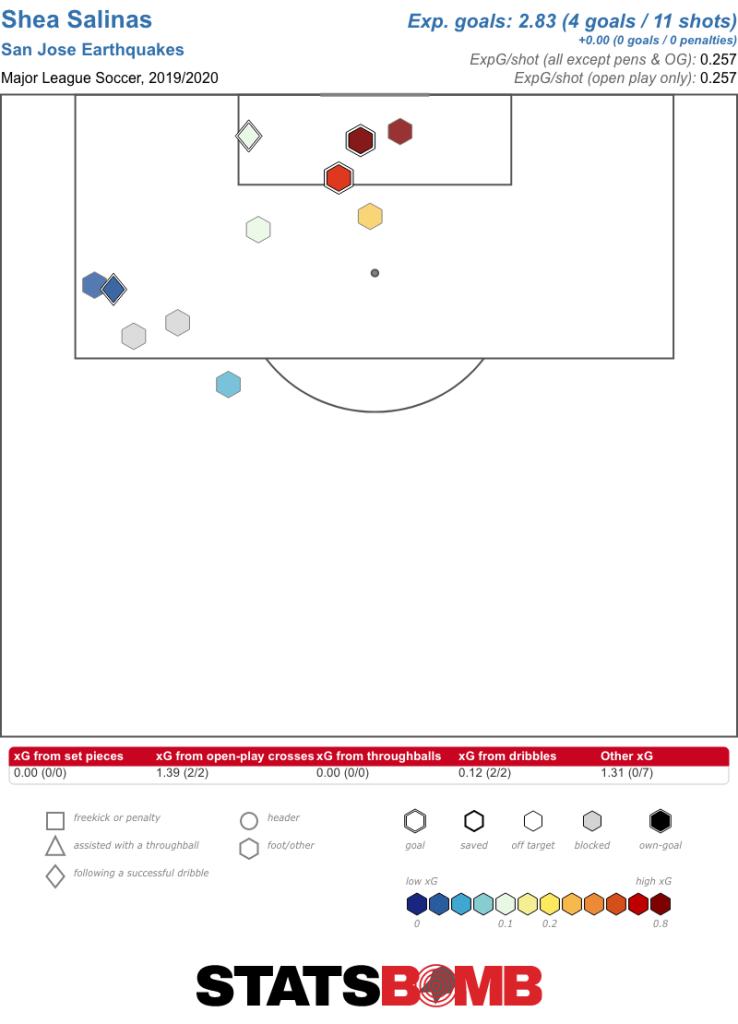
Salinas, primarily a left-back in recent years, has notched four goals to date, already making it the highest scoring season of the 32-year-old’s MLS career. He joins Lima (previously a right-back), Thompson (previously a midfielder) and Eriksson (a wide man turned central attacking midfielder) in taking on an unfamiliar position under Almeyda.
But how have all of these changes transferred to chance creation and results? Last season, San Jose’s average expected goal difference (xGD) per match was 0.63 -- the second-worst record in MLS. It has improved, but it is still in negative territory, at -0.44 xGD per match. That is one of the six worst records in the league, although it must be noted that it is heavily influenced by a pair of dreadful defensive performances in early defeats to New York Red Bulls and Los Angeles FC. At both ends of the pitch, things are starting to trend positively (the second vertical line on the graph indicates the start of this season, and thus Almeyda’s time in charge).
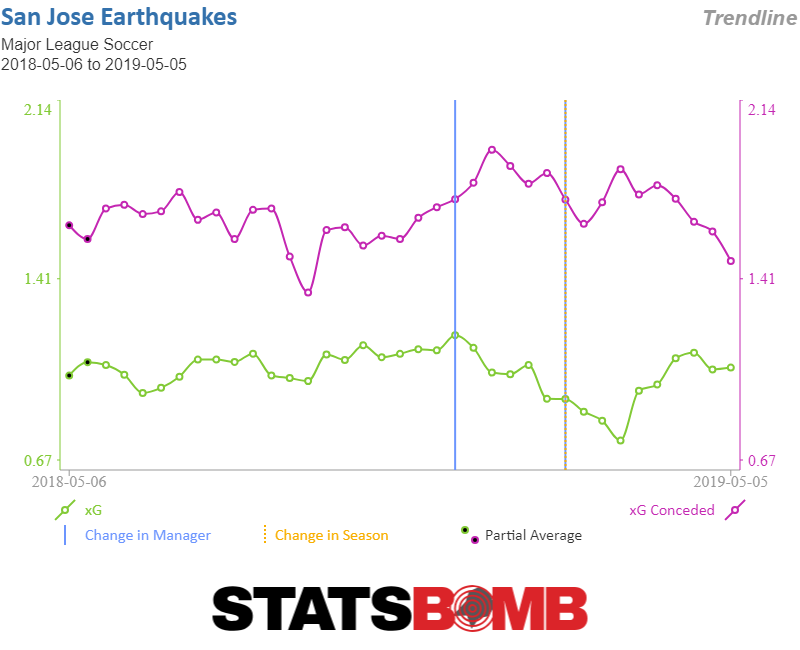
There seems to be confidence amongst the players that things will continue to improve as they get used to Almeyda’s system and the demands it makes of them, but there is certain to be a point at which he begins to push up against the limitations of the squad. Even with some solid pickups in the off-season -- Espinoza chief among them - this is still largely the same group who came bottom of the pile in 2018.
San Jose finished a full 28 points shy of the playoff places last season, and expecting Almeyda to turn that deficit around in one season, even after a promising start, would be asking an awful lot. This should be a campaign for bedding in his ideas, identifying personnel deficiencies and putting a framework in place to make a proper push for a playoff place in 2020. Almeyda has showed himself capable of turning teams around if given time to do so, and the early signs are that he might just be able to repeat the trick in San Jose.
Villarreal's Samuel Chukwueze Could Become a Star, if His Right Foot Doesn't Get in the Way
Heading into the 2018–19 season, there was little to suggest that Villarreal were going to have a difficult league campaign. Having talents like Rodrigo and Samu Castillejo depart over the summer was a blow, but the club spent amply ion the market for capable players like Santiago Caseres, Karl Toko Ekambi, and Gerard Moreno. There was still enough collective talent on the squad to think that Villarreal would once again hang around the Europa League spots. However, that's not been the case. They've had a campaign from hell, flirting with relegation for the majority of the season. It's been chaotic enough that their current manager Javier Calleja is on his second stint within this season alone, coming back in late January after his initial firing in December.
Even with all that the disappointment, there have been a couple of bright spots. Given the severity of the medical procedures he’s endured, Santi Cazorla playing over 2000 league minutes at a high level is a minor miracle. The other bright spot has been the emergence of Samuel Chukwueze, who has been electric on the wing for Villarreal recently in La Liga. Given the overall struggles that the club has faced, having a scoring contribution per 90 rate of 0.47 as a 19 year old in his debut season is no small feat and it’s easy to see why he’s been tipped to do big things in the future. Putting up higher than league average shot volume with around league average xG contribution are positive indicators for future success
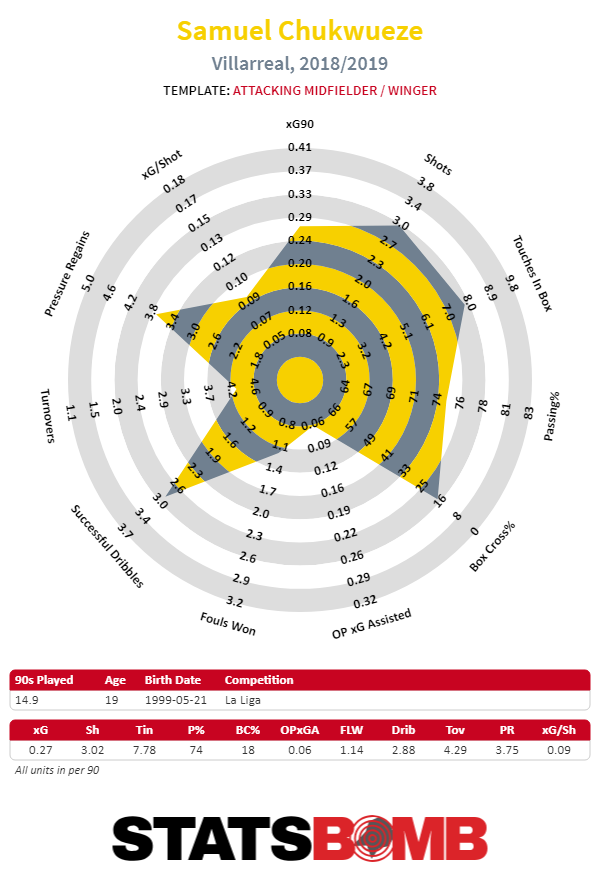
It hasn’t been all rosy for Chukwueze in his maiden voyage, as he was limited to sub appearance for a two month period between January and March, but he’s still on pace to play over 1500 league minutes, which isn’t an insignificant amount. Though it’s by no means definitive, the mere act of getting consistent minutes in a big five league for young talents is encouraging. And when he’s at his best, the young winger has a sort of electricity that's made him must see TV. What's interesting with Chukwueze is that his dribbling is sort of one dimensional; he always wants to get to his left foot and cut inside. He doesn't use his speed to pose much of a threat to get to the byline and cross the ball, but he's effective in using feints and his first step when cutting inside because he's possesses a high level of burst.
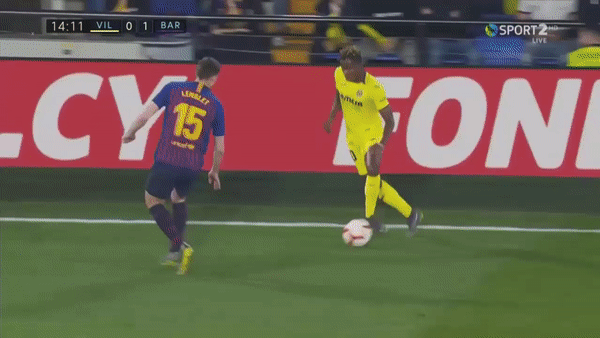
Another area where you see Chukwueze's athleticism is whenever he tries to make off-ball runs, especially during transition opportunities. He can make either looping runs where he sees an opening in the middle between opposition defenders, or be on the blindside of an opponent before bursting into the right wing and isolating himself against a lone defender. Sometimes he'll combine both his off-ball movement with quick flicks off his first touch when receiving the ball to get the defender off-balance (his ability to control passes during counter attacks without breaking stride with his running is quite strong).
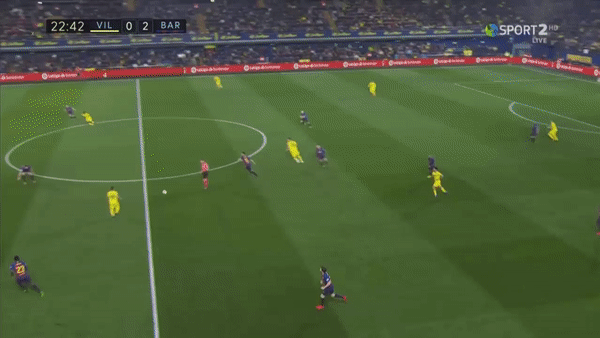
Chukwueze's passing and shooting are more of a mixed bag. The ample shot volume is a positive at just over three shots per 90 minutes. His shot map is not a surprise for an inverted winger, especially one that doesn't play on a high powered attack. Wingers who don't play in highly coordinated systems are more susceptible to having a high volume of shots taken from the wide areas, which are tough areas to score from on a consistent basis and help contribute to a lower xG/shot. When looking at film, it was noticeable to see that a fair amount of Chukwueze's shots were ones where there weren't better options besides shooting into traffic from the right channel and hoping for the best.
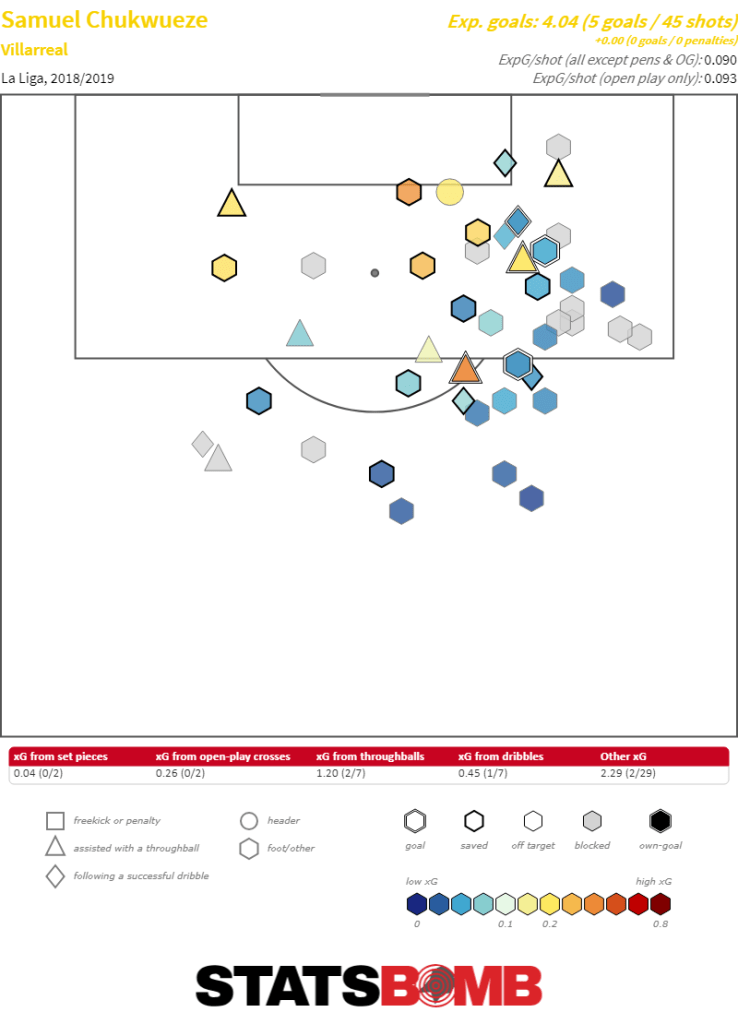
I think it would be a stretch to say that Chukwueze is a net-positive as a passer at this point, but it's not like he has cinder blocks for feet. He can make functional passes from the wings into the channels, or switches of play when more attention is being shown his direction. During counter attacks, he'll spot a teammate get into open space and try to feed him the ball to varying levels of success. Where Chukwueze's passing falls off is when he tries to make the type of impact passes that lead to high quality scoring chances. He's just doesn't have quite the touch to connect on incisive passes with a higher degree of difficulty. That isn't necessarily a death knell. It's good that he's at least got the awareness and gumption to attempt these passes, which is half the battle with young attackers. It's fair to wonder how much of this can be improved over time with more experience, but there's a chance that he's simply not going to grade out as a decent playmaker.
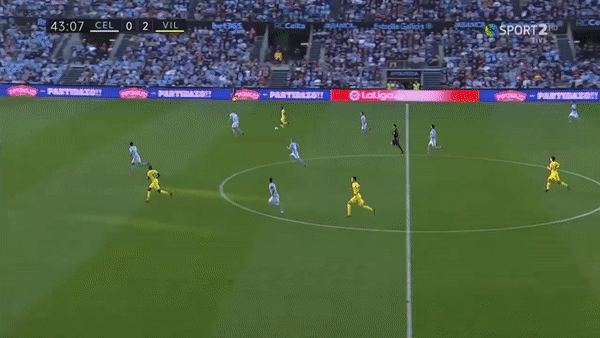
Probably the biggest concern with Chukwueze is the degree to which he is one footed. If you think of footedness as a spectrum, Ousmane Dembele would represent one end of the spectrum among young attackers. He's someone who brings clear value because he can do productive things with both feet. As you start moving from that end of the spectrum of the other side, there's more polarization and an increasing percentage of on-ball events become located on a player's favored foot. Chukwueze is all the way at the one footed end end, because it's very clear that he's left-footed. We already alluded to this with his dribbling and ball carrying during transition. His shooting comes almost entirely from his left foot, as well as his passing. It's not uncommon to see instances during transition opportunities where the ball swings to him, he'll carry the ball into the box and square passes with his left foot rather than try lob passes to the far post with his right.
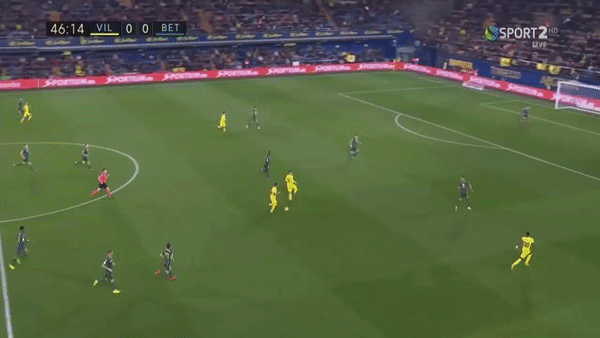
Chukwueze's left-footed dominance is similar to another attacking prospect in David Neres, which makes for an interesting comparison. Both Neres and Chukwueze aren't threats to attack the byline with their right foot and create chances. In terms of overall passing and on-ball coordination, Neres suffers from his lack of right foot usage but he's still shown considerably more self-belief than Chukwueze. Chukwueze's advantage over Neres is that because he's a much better athlete, he's has more impact as a dribbler because he can create a greater level of separation when he uses feints and sidesteps to get to his left foot. Whenever Chukwueze gets the ball with his back to goal he can quickly turn with the ball and create distance from his opponent allowing him to move into the halfspace with relative ease, whereas Neres can't do that.
All-in, Chukwueze seems like a relatively strong prospect. He's dynamic enough as an athlete that he can get away with being so reliant on his left foot, at least to some degree. A bit of my optimism stems from overvaluing highly athletic wings that show snippets of awareness with their passing. There is the possibility that his passing never really evolves from its current state, which would make the path to stardom fairly hard, so passing is a big swing skill for him. There's also the fear that even with his near elite athleticism off the dribble, his left foot dominance could be scouted harder and lead to more growing pains. Even though his shot locations and volume aren't optimal, I'm not particularly worried given that a lot of it could be chalked up to the environment he's in at Villarreal.
Perhaps the biggest fear with Chukwueze is whether there are enough low-hanging ares of improvement n his game to make notable gains. He already doesn't have tunnel vision so rarely gets himself in trouble dribbling down dead ends, nor is he shooting at such a ridiculous volume with poor locations. It's going to boil down to his passing and growth in off-foot capabilities. If we see noteworthy growth in his passing and any shred of progress in right foot usage, then the odds are good that Chukwueze will become a star level talent. If not, then it's going to be harder for him to justify a big price tag on a future transfer fee. Year one for Chukwueze has been a success, and how years two and three pan out will be vital in projecting the type of player that he becomes.
Iago Aspas Is Celta Vigo's One Man Rescue Operation
Celta Vigo would almost certainly be on the road to relegation if they didn’t have Iago Aspas.
Their points-per-match rate from the 20 matches he has started this season would see them in contention for a top-eight finish if it had been maintained through the campaign to date; their points-per-match rate in the 12 matches he hasn’t started is so low that they would barely have made it into double figures if that had been their season-long average.
On a per-match basis, Celta have scored 64% less goals, conceded 17% more and taken 76% less points when Aspas hasn’t been in the starting XI. In the three month period at the start of this year in which a couple of calf injuries prevented him from making a start, Celta recorded just one league victory, alongside nine defeats and a draw. His return coincided with a haul of seven points from three matches that have at least temporarily lifted them out of the bottom three despite a 2-0 defeat, with Aspas suspended, to Atlético Madrid at the weekend.
When Aspas is involved (in his 20 starts and one substitute appearance), Celta Vigo take 33% more points than their average (1.33 to 1) for the season, ranking him fifth in La Liga by that measure amongst players who have seen more than 1,400 minutes of action, as per TransferMarkt. He is one of only two attacking players to have made more than a 20% difference to his team’s outcomes.
The expected goal figures posted by Celta with and without Aspas are not quite as dramatically opposed as those top-line numbers, but there is still a significant drop-off when he isn’t involved. Prior to the defeat to Atlético, with Aspas on the pitch they had averaged 1.11 expected goals (xG), 1.41 expected goals conceded (xGC) and average expected goal difference (xGD) per match of -0.29. Without him, they had averaged 0.69 xG (38% less) and 1.51 xGC (7% more), leading to an average xGD of -0.82, just over half a goal worse than with him present.
That Celta struggle to such a degree when Aspas is absent is unsurprising when one notes the degree to which he dominates their attacking output. Despite missing over a third of their matches this season, he has still made a direct contribution (scoring or assisting) to 18 non-penalty goals (0.90 per 90), five more than any other player. He has scored 13 times from open play (significantly over-performing his xG in the process) and twice from the penalty spot.
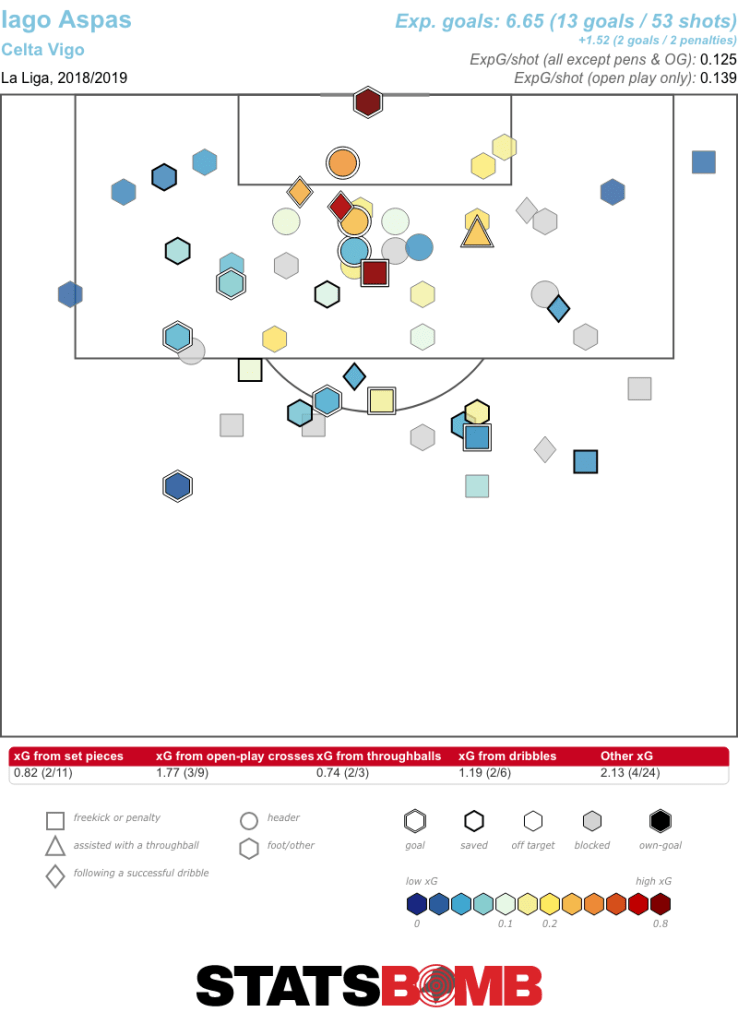
On a per 90 basis, he leads the team in shots and key passes, and in both xG.

And xG assisted.

Across the whole of La Liga, only Lionel Messi of Barcelona has provided a higher percentage of his team’s xG contribution (xG + xGA) on a per-match basis, with 61% to Aspas’ 54%. Alongside Ángel of Getafe, they are the only three players with contributions above 50%. Widening it out a little, Aspas has touched the ball at one stage or another of the moves that have led to 76% of Celta’s xG output per match.
It can be of no surprise that all within the club are happy to have him fit for the run-in. “He is a decisive player because of his quality and what he provides to the group,” coach Fran Escribá said recently. “Aspas is different kind of player, our reference point,” defender Gustavo Cabral said last year. When he broke down into tears after scoring two goals in his first start back against Villarreal last month it was partly because of the pressure that had been building up on him during his layoff -- the pressure he had put on himself and the pressure that was applied externally by the expectations of supporters and even teammates on what is the youngest squad in La Liga. “For many of my colleagues, the fact that I was out on the pitch helped them emotionally,” he explained afterwards.
Aspas was not quite such a talismanic figure at the time, but this is not the first occasion on which he has had a key part to play in saving Celta from a relegation battle. He was one of five members of the current squad (and two of the coaching staff) involved in their miraculous escape in the 2012-13 season. Given just a 4% chance of survival, they recorded back-to-back wins over Real Valladolid and Espanyol to leapfrog three teams and maintain their top-flight status. Indeed, it was Aspas who skilfully skipped past an opponent and squared for Nacho Insa to score the decisive goal in the final-day win over Espanyol.
But it also possible to go back even further than that, to June 2009, when a 21-year-old Aspas was just starting to work his way into the first-team picture at Celta having come up through their youth ranks and B team. The club were struggling badly at the bottom of the Segunda División, with relegation a real possibility. In a crunch match against Alavés, Aspas came off the bench for only his second appearance and scored twice, including the winning goal deep into stoppage time.
Can he inspire Celta to another survival? Even with him in the side, their underlying numbers are still some of the poorest in La Liga. With six matches to go, they have just a one-point cushion over the bottom three. Home matches against fellow strugglers Girona and Rayo Vallecano are likely to prove key. “I’m not going to give up until the very last match,” Aspas said after the win over Villarreal. With him by their side, his teammates won’t either.
Header image courtesy of the Press Association
Luka Jović, Europe's Next Big Thing
Right now, Luka Jović might be leading the line for Entracht Frankfurt against Benfica in the Europa League, but he's also auditioning for a much bigger job.
Sunday June 2nd. Twenty-four hours removed from the Champions League Final, European football’s second season begins. Clubs across Europe take stock and evaluate. When they do so, there is only one name that will cross the lips of those searching for a new striker, Luka Jović .
Eintracht’s Serbian attacker has drawn many admiring glances in plundering the Bundesliga this season, firing Frankfurt into the hunt for Champions League football in 2020. He has managed 16 league goals from an expected goals total of 11.31, accounting for 25% of his team’s total in the process.
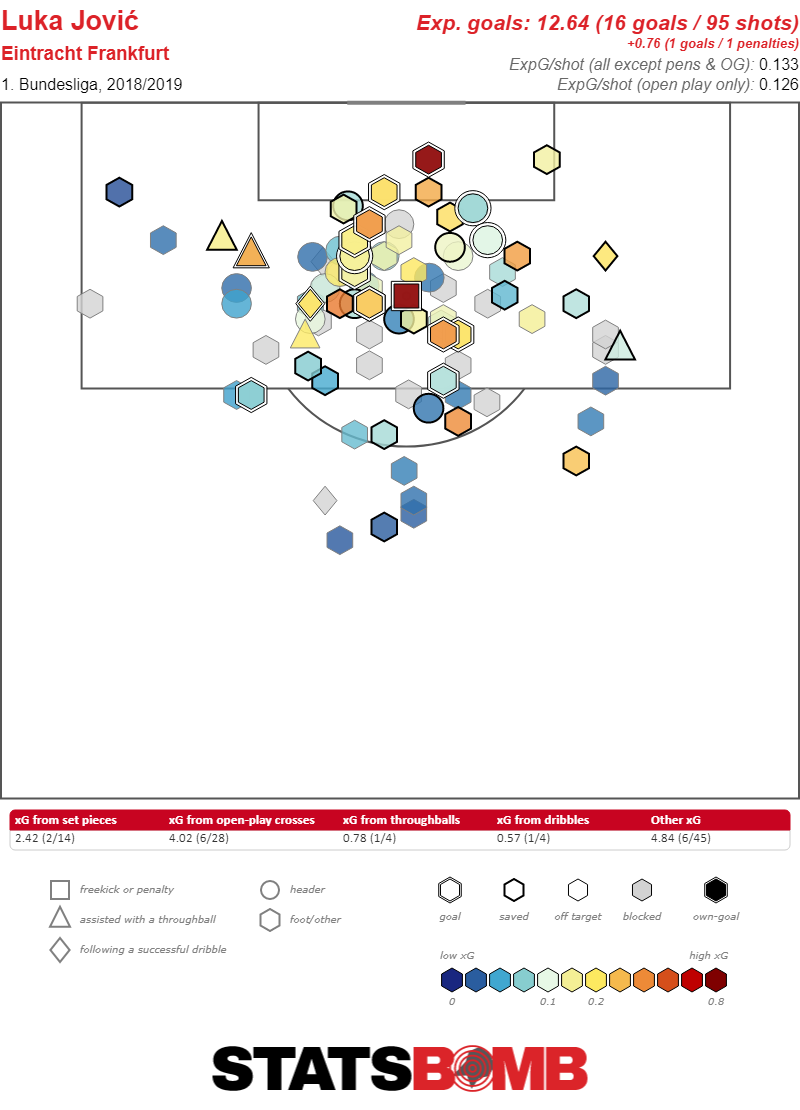
In Catalunya, Barcelona are rebuilding one final team around Lionel Messi. Latest signing Frenkie De Jong joins Arthur Melo, Ousmane Dembélé and Malcom (if he’s not shipped out) as youngsters who will be key figures at the Camp Nou over the next decade. Amongst these facilitators is the ideal landing spot for this prodigious striking talent.
Luis Suárez is an aging force, but the role he plays in allowing the Blaugrana and Messi to be effective often goes unnoticed. Jović’s feisty personality and central-centric playstyle are the most akin to the Uruguayan in Europe. Physically and statistically he would not have to make much of a leap to fill the considerable void of El Pistolero.
At 5’11 he is not overly big compared with the prototype centre-back of 2019, yet neither is Suárez at 6’0.
Jović takes up advanced positions, trying to play on the shoulder of the deepest central defender. In a Frankfurt team that has 251 less passes per game than Barça he still manages to register 12.71 touches in the box per 90 minutes as well as accumulating 3.21 deep progressions per 90, highlighting a willingness to get involved in the buildup before positioning himself in the box, something key to the Barcelona pattern of play.
Comparatively, this season Suárez has 15.34 touches in the box but fewer deep progressions (2.38) than Jović. The differentials are easily explained by the gap in possession figures between the sides and what Jović is asked to do by manager Adi Hütter.
Already adept at playing with his back to goal, Jović’s tendency to spin and move directly into the box after the layoff meshes well with Messi’s predilection for moving laterally in possession before playing passes between the opposition centre back and fullback for the Barcelona wingers to move onto. Visually, a lot of Suárez goals come from balls played across the box that he subsequently finishes, an observation backed up by his shot chart.
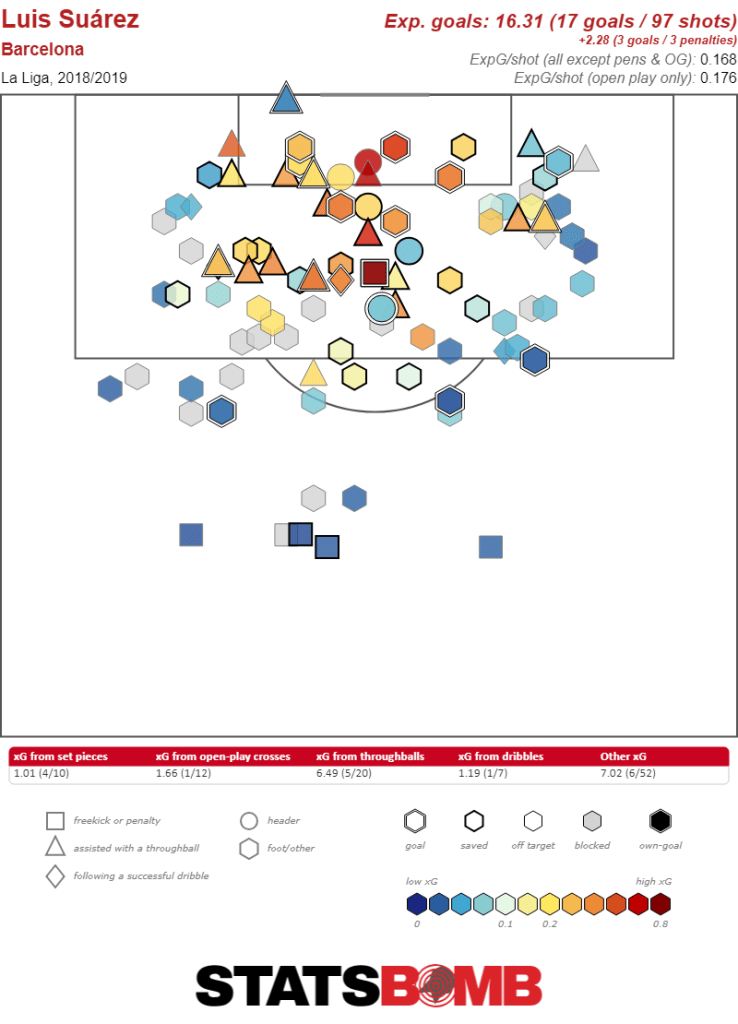
Jović doesn’t have quite the same tendency to end up virtually on top of the goal, but his shots still come from extremely central and dangerous areas, and it’s not hard to imagine that given the gift of receiving the ball from Messi, he too would pop up on the end of an endless barrage of tap-ins. The difference in location is why despite having the exact same expected goals per 90 (0.55), Jović’s comes from slightly higher shot volume 3.90 as opposed to Suárez’s 3.25.
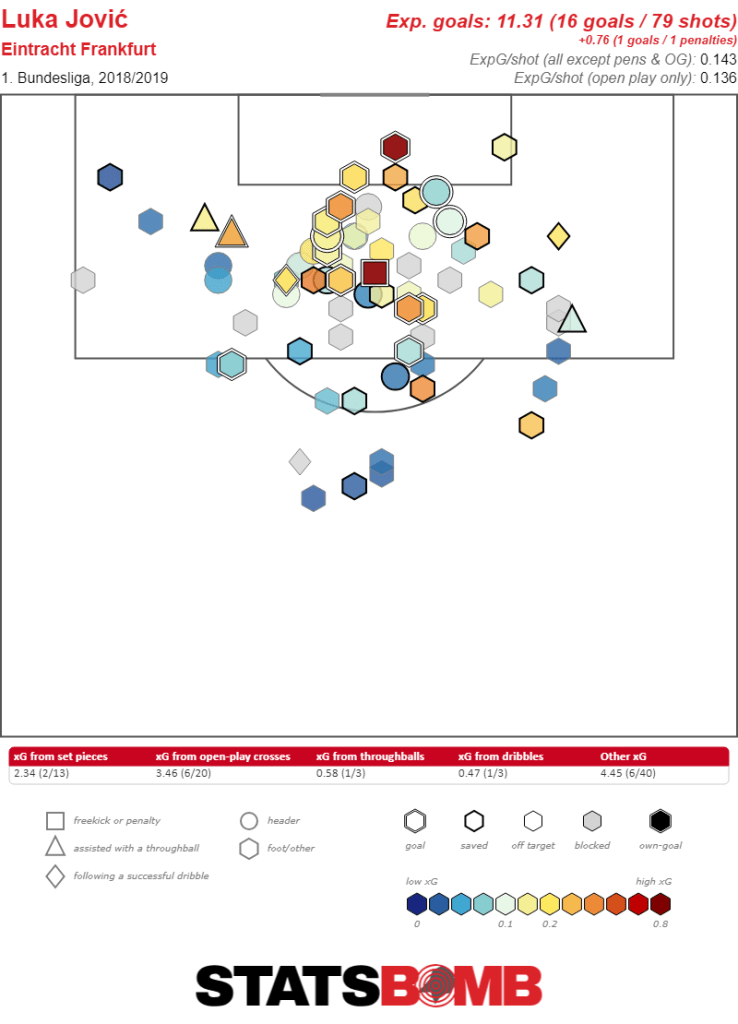
In defense, Jović’s youthful mobility and endeavor make him the perfect foil in the press quick and high system employed by the Blaugrana. While his current team are not particularly committed pressers (Frankfurt’s average defensive action takes place 44.35 yards from their own goals, five Bundesliga teams are more aggressive), Jović still acquits himself well.
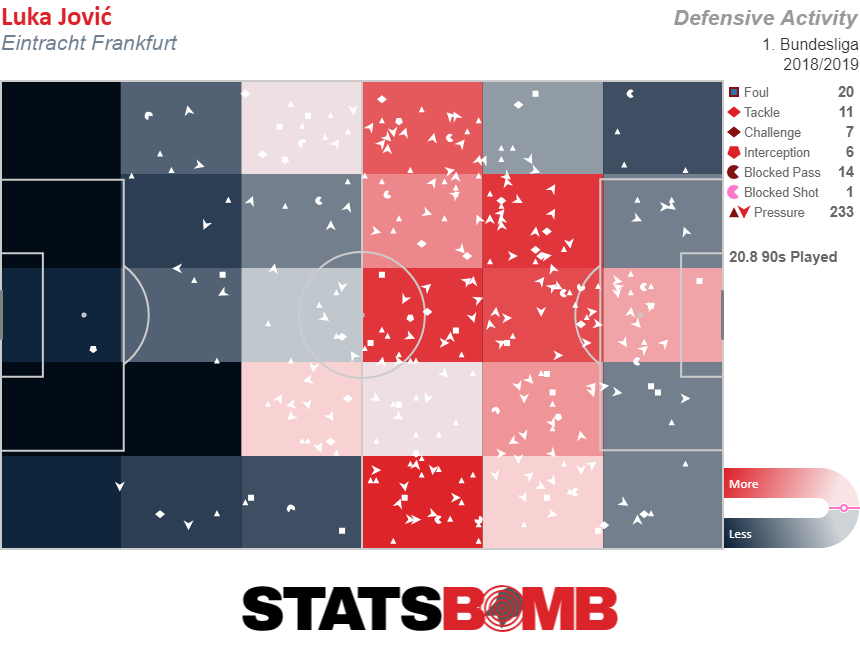
And while Suárez continues to fly around in Barcelona’s press, at 32 years old the perpetual pressing machine is the first thing that’s likely to slow down. As his movement declines it will definitely hinder Valverde in his attempts to impose a proactive pressing philosophy on the team.
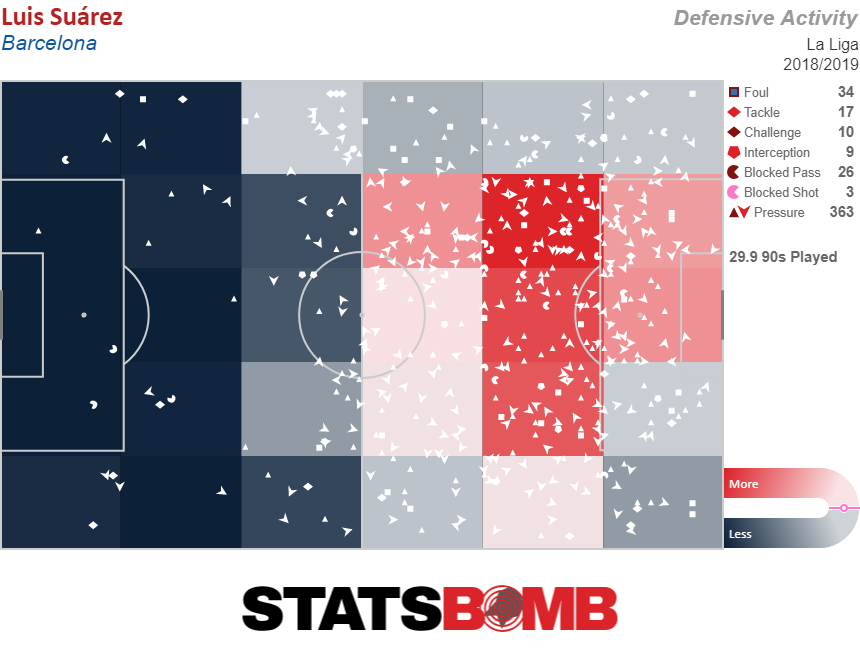
The biggest statistical gap between them is in aerial duels, where Jović completes four times as many as his Uruguayan counterpart but this can be put down to the German team having a more even split of possession with their rivals and a more distinctly direct style of play.
Moving away from the nitty gritty numbers, the striking similarities between the two are even more apparent. Suárez has excelled as one of Barcelona’s great central strikers by owning the area of the pitch between the box. He is rarely required to take up positions in the channel or move from outside to in, both of which would not be strengths of Jović’s game. He prefers to use his imposing muscular frame to promote verticality in the team movement.
Suarez has been lucky enough to be part of the greatest club team of all time with Messi, Neymar, Iniesta, Xavi et al and in their latest spending splurge, Barcelona are preparing to solidify that dominance once more before Messi leaves for his Argentinian swansong at Newell’s Old Boys (a romantic can always dream).
The current group will have a lot to do to emulate that vintage, but it looks as if Eric Abidal is trying to go as like for like in replacing some of his legendary former team-mates. In Jović he could have a plug and play replacement for a player that has given 129 goals in 159 games since arriving in 2014.
Eintracht are well aware of the growing interest in their prized asset with Bayern and Chelsea, if they dodge a transfer ban, also both sniffing around the Frankfurt stands. The asking price appears to grow exponentially with every goal, and may currently stand at 60 million euros, but you imagine it will come down to the players preference with all three teams having an endless bankroll.
If Jović does become Barcelona’s eighth signing aged 23 or younger in the last two seasons, there won’t be a team in Europe with a greater balance of youth, quality and depth.Brace yourselves for another period of sustained Catalan dominance at the forefront of European football.
The Meteoric Rise of Porto's Eder Militão
Eder Militão is the son of a footballer, but it took him a while to embark on the path trodden by his father. When he was younger, he could more often be found riding his bike and flying his kite than playing with a ball out on the street. His interest arose suddenly, and his ascent was even swifter. He started playing for a local team at 12, signed on with São Paulo at 14, made his first-team debut there at 19, and then moved to Europe with Porto at 20.
Last month, three quarters of the way into his first campaign there, Real Madrid confirmed that they had agreed to pay his release clause of €50 million and sign him to a six-year contract that starts this summer. At 21, he became the most expensive defensive signing in their history.
“He has surprised everyone with how easy the transition has been for him,” says Michael Beale, who worked closely with Militão during his time as an assistant coach at São Paulo under Rogério Ceni. “I think he is naturally growing with each game he plays and each challenge he is set. He has risen to the challenge extremely well and it’s a big accolade that Real Madrid wanted to sign him.”
“He is a very intelligent boy who likes to listen,” his usual central defensive partner (and fellow Brazilian) Felipe said back in October. “He takes everything in straight away. He found his level quickly, as if he had been playing with us for a long time.”
Not only has Militão been part of the best defence in Portugal this season (in terms of both actual and expected goals conceded), but he is also a member of the side who have put together the club’s best Champions League run since the 2014-15 season. The first leg of their quarter-final against Liverpool takes place at Anfield on Tuesday.
Since the January return of Pepe -- at the time, Madrid’s most expensive defender when he made the same move from Porto for €30 million back in 2007 -- Militão has often been shuffled over to right-back, but it is in the centre of defence that his future lies at both the club and international level. In that position, he has shown the same qualities that originally convinced Ceni and Beale to move him up into the first-team group at São Paulo.
“Eder had big qualities,” Beale tells StatsBomb. “He was a player who was playing for the junior Brazilian national teams and had already alerted a few of the big European teams. He was athletic, strong and technically very good. He was also confident (in a nice way) and eager to take his chance.”
Once promoted, Militão formed part of an exciting young squad that also featured David Neres (Ajax), Luiz Araújo (Lille), Lyanco (Torino), Júnior Tavares (Sampdoria) and Lucas Perri (Crystal Palace) -- a group that Beale says was as good as any he worked with during his time with the youth teams of Chelsea and Liverpool.
In the first team, Militão was initially employed as part of a back three, tasked with using his ability in possession to help build play out from the back. It was an attribute that had been evident during his time in the club’s youth teams, where he sometimes played in midfield, and has carried over to his initial experiences in Europe. His willingness to carry the ball past opponents into space, even if it means moving onto his weaker left side, makes him a valuable asset for a team seeking to move forward out of defence.
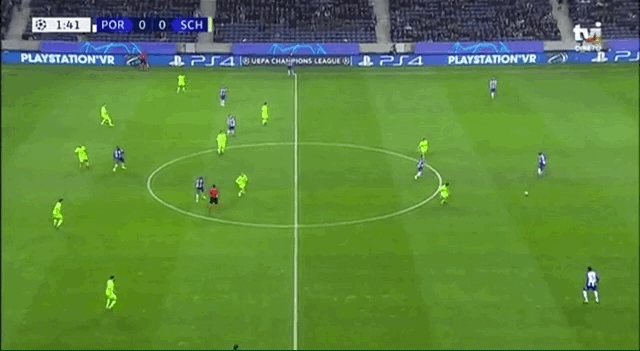
Most of his shorter passes are fairly simple, but he does occasionally pick out some interesting angles.
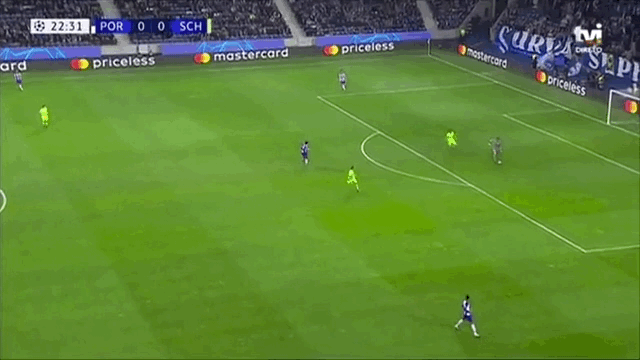
He also does a pretty neat impression of the sort of casually lofted ball forward that Sergio Ramos, the man he will be expected to deputise for and perhaps eventually supplant in Madrid, has long made his trademark.
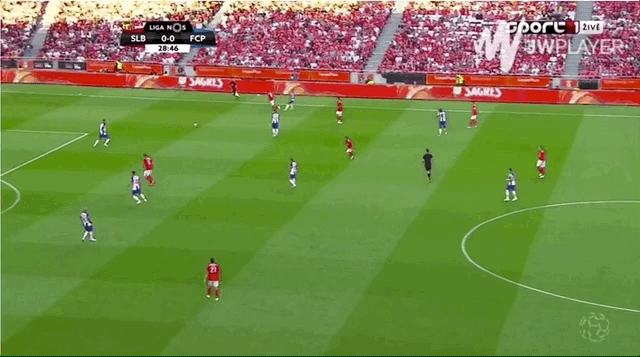
When Militão first began training with the first team at São Paulo, there were a couple of things that really stood out about him. “Personality,” Beale explains. “That is the key for all young players. He came into the first-team group and immediately wanted the ball and wanted to show what he could do. That, and his aggression out of possession.”
On that second point, there is more than a little bit of Ramos in the way Militão tackles every defensive situation with full confidence -- rightly or wrongly -- in his ability to resolve it. He occasionally takes risks, but always with the knowledge that he has the pace, physique and tenacity to rectify anything that doesn’t initially work out for him.
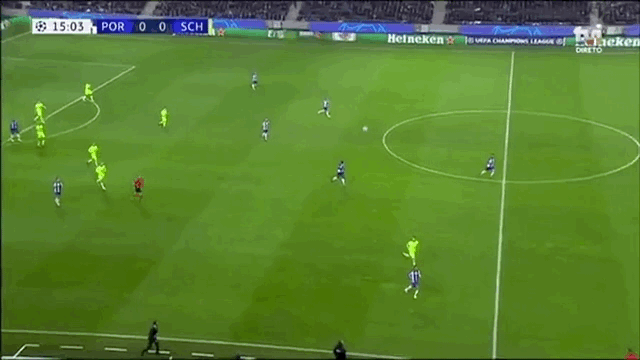
Brazil coach Tite recently highlighted Militão’s supreme recovery pace as a quality that would give his side the ability to play with a higher defensive line, and that is just one of a number of physical attributes that give him the necessary reach to hedge his bets when taking up a defensive position. Despite standing six foot two inches tall on a relatively gangly frame, he is still supple enough in changing direction to cover off various angles.
Take this example of a period of play from Porto’s 0-1 defeat away to Benfica earlier this season.

That is not exactly textbook defensive organisation. A lot of space opens up between Militão and his central defensive partner Felipe. But Militão has nevertheless put himself in a position whereby he is well-placed to defend any attempt to play the wide runner in behind, has covered the clearest angle for a pass slipped into the penalty area, and can use his height to provide a barrier for a near-post cross -- the eventual outcome.
Playing in that manner requires good understanding and a solid supporting structure, which Porto usually have in place. That was particularly the case with the Felipe and Militão defensive partnership that took them through the Champions League group stage. Militão was normally the more proactive of the pair in stepping forward to deal with danger, but their roles were fairly interchangeable, with each covering for the other when necessary. If that same support network isn’t there in Madrid, he could be more exposed.

Beale, though, believes that next step will not be beyond the capabilities of a player whose desire to push and improve himself has always been clear. “He had a big talent and matched it with a big motivation and need to be successful,” he explains. “Then it’s all about opportunity and how a player reacts to that opportunity and increased expectation. You can see his energy now at Porto. He hasn’t lost any hunger to achieve more and more.”
If there is one final nagging question mark hanging over Militão’s assured and impressive performances this season, it is the quality of opposition he has come across to date. Porto are yet to play any of the top 25 teams in FiveThirtyEight’s Global Club Soccer Rankings, while Benfica (3oth) are the highest ranked of the three top-50 sides they have encountered. By that measure, and surely general consensus, Liverpool and their fearsome front three will represent by far the sternest exam Militão has yet faced.
“I think it’s the greatest challenge,” Beale says. “Knowing him, I’m sure he is looking forward to testing himself against Sadio Mane, Mohamed Salah and Roberto Firmino. He is a young and fearless right now. I’ll be watching with interest.”
